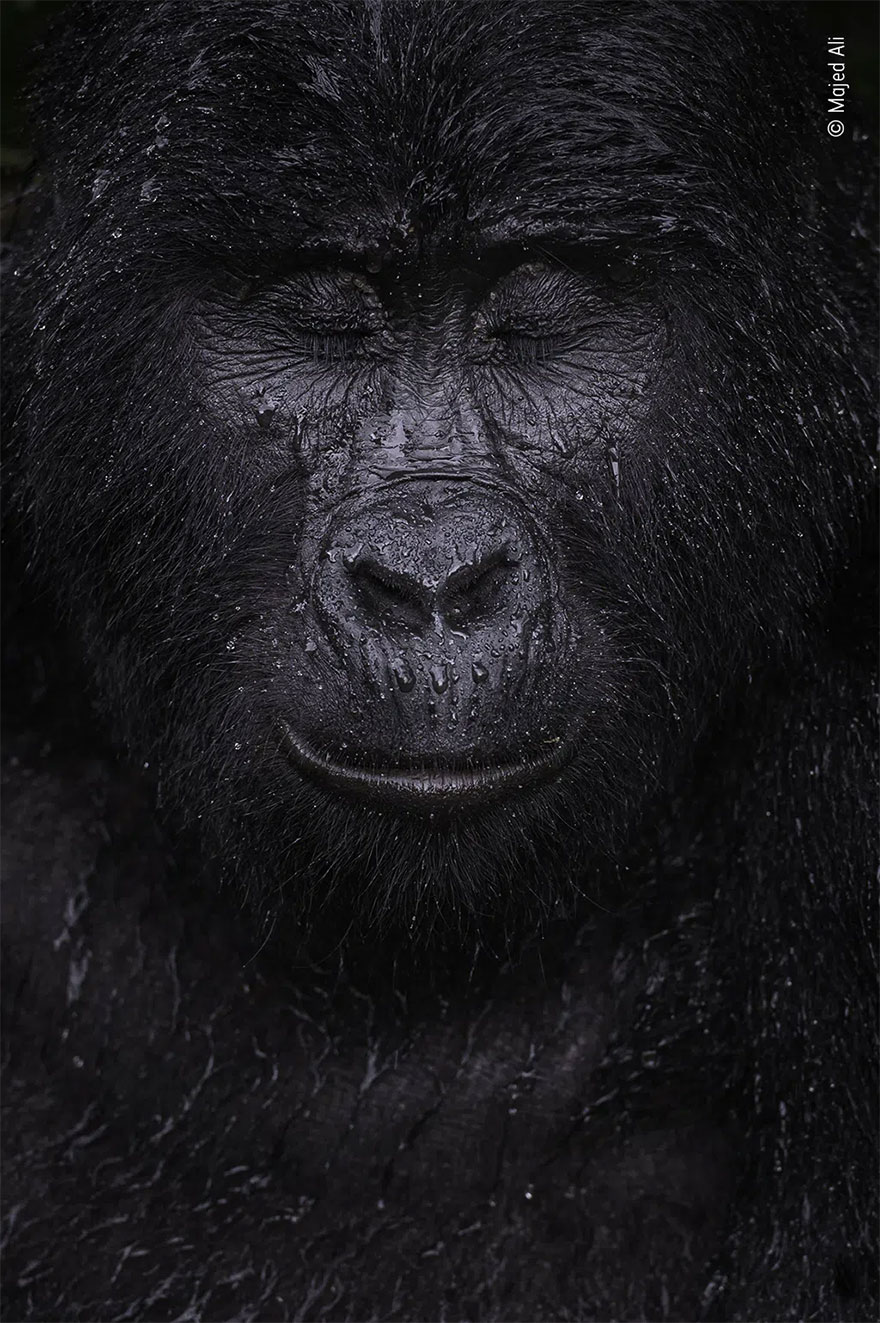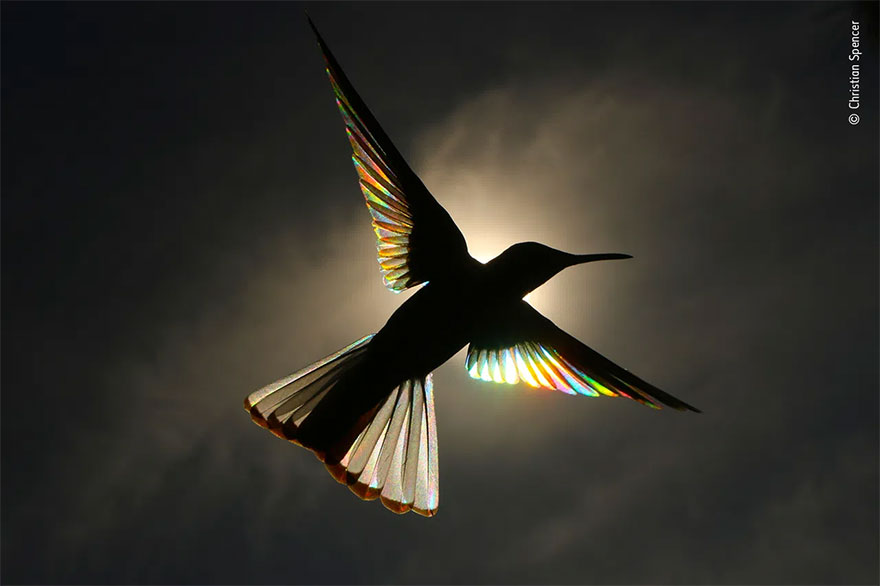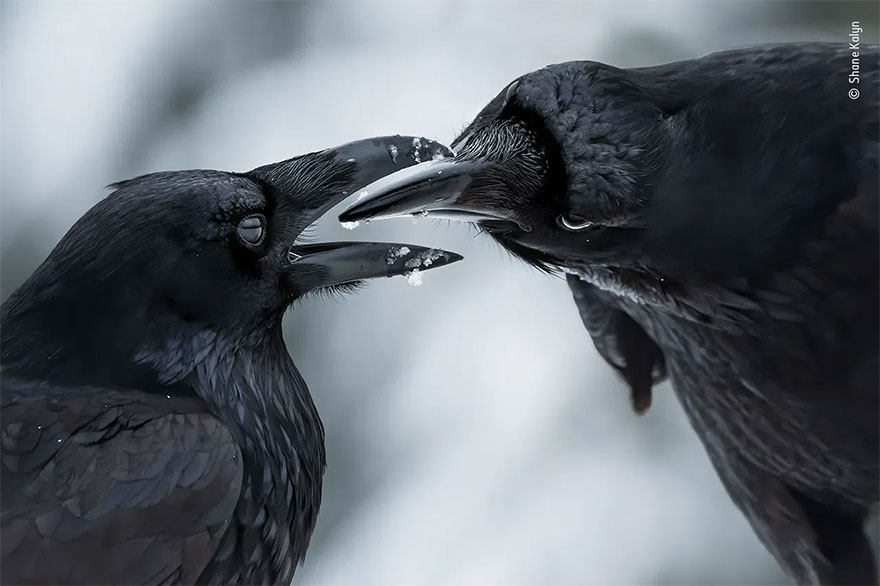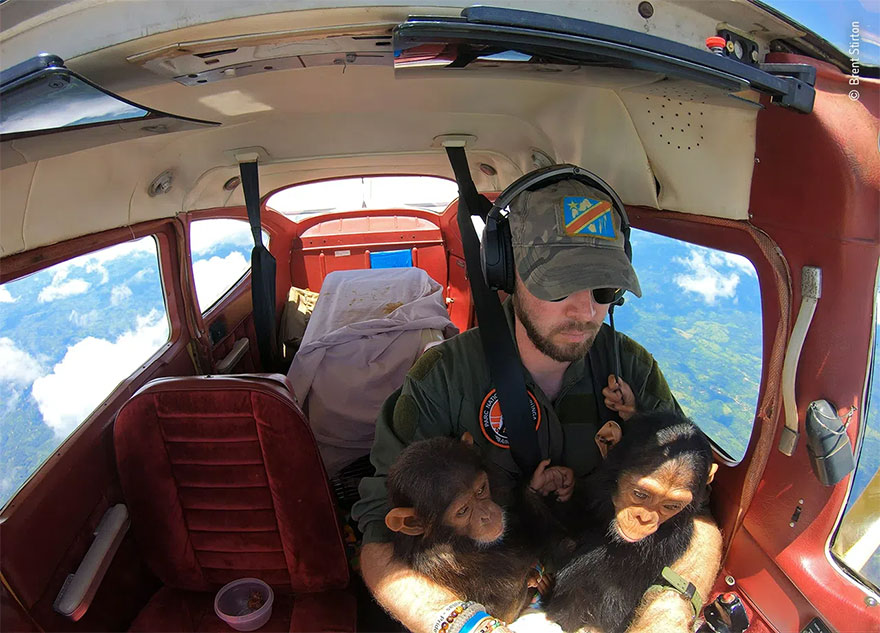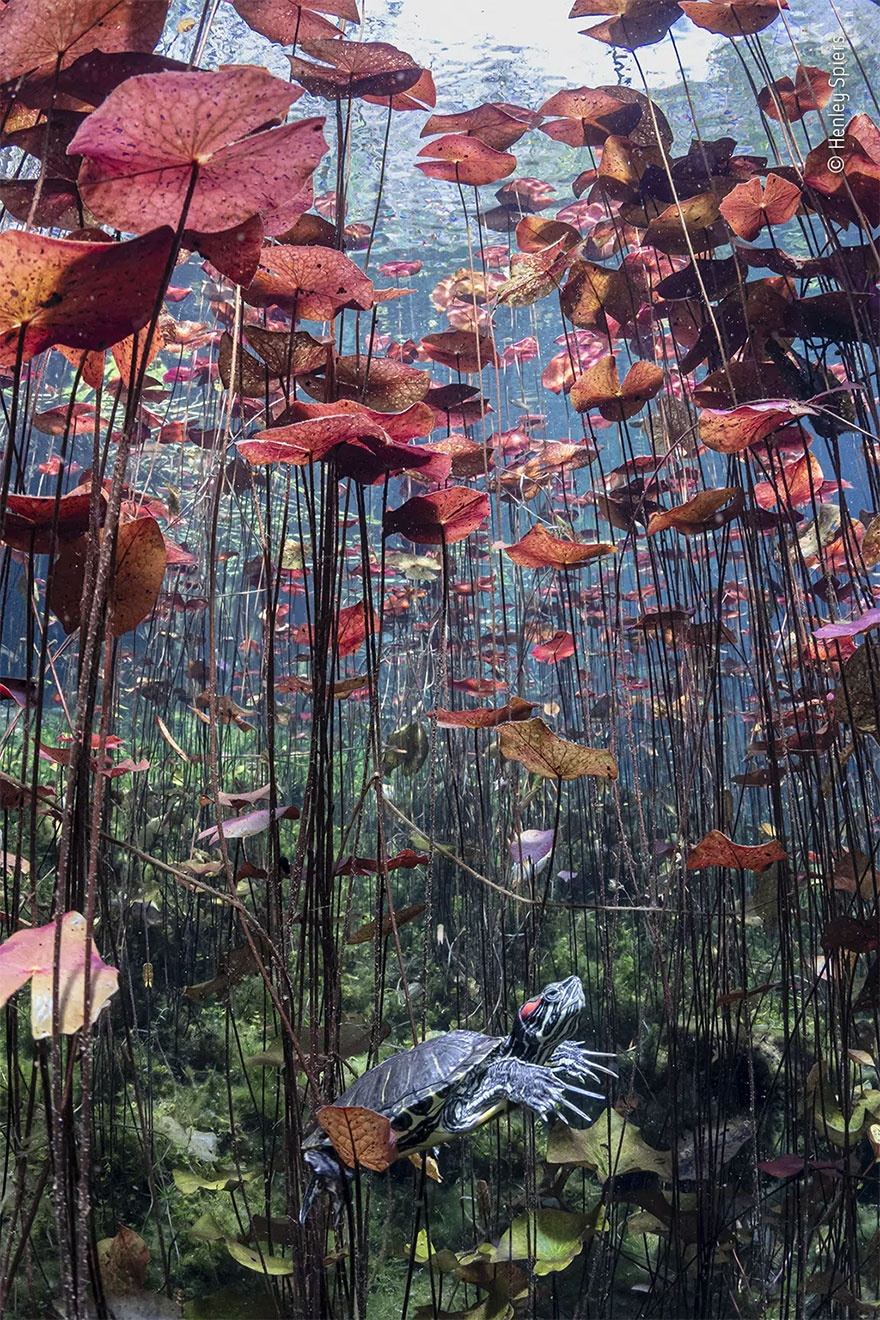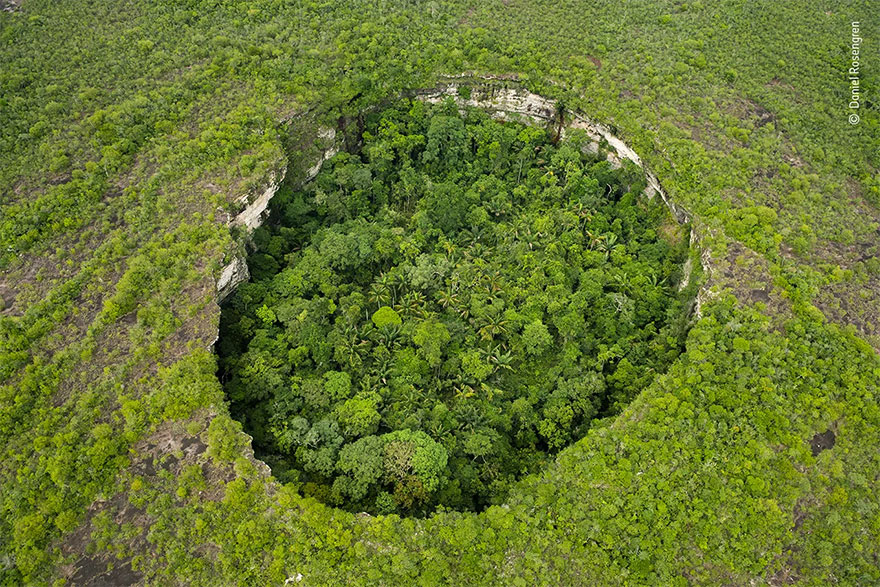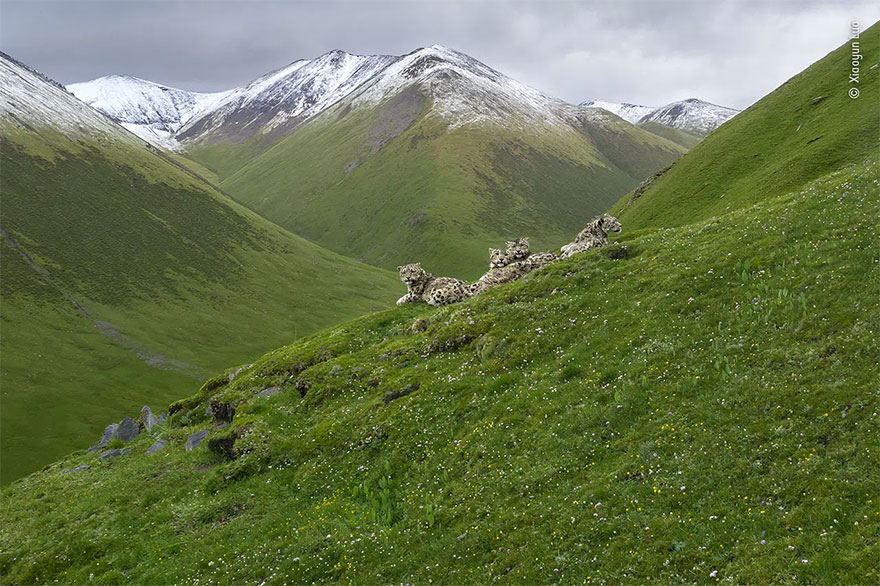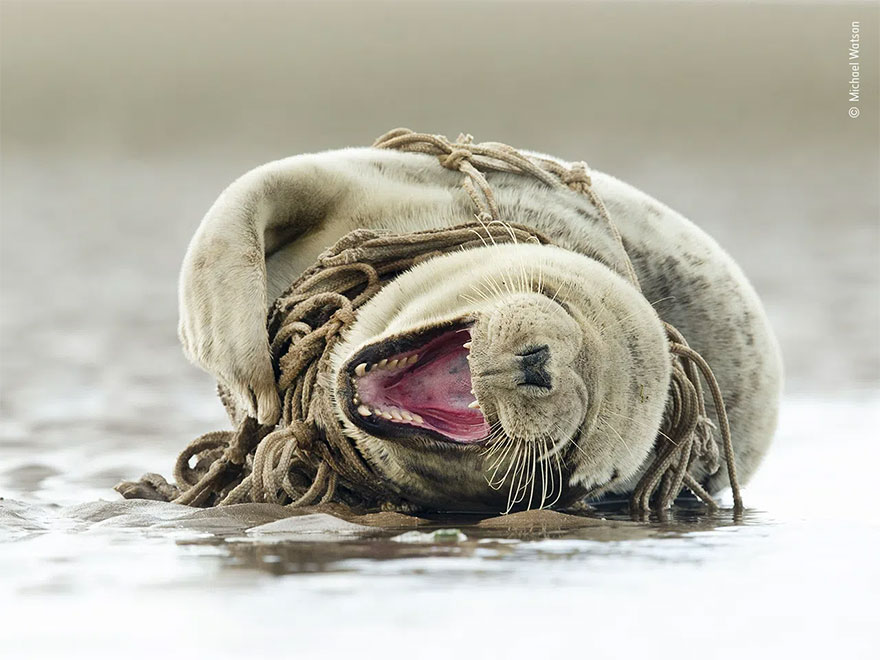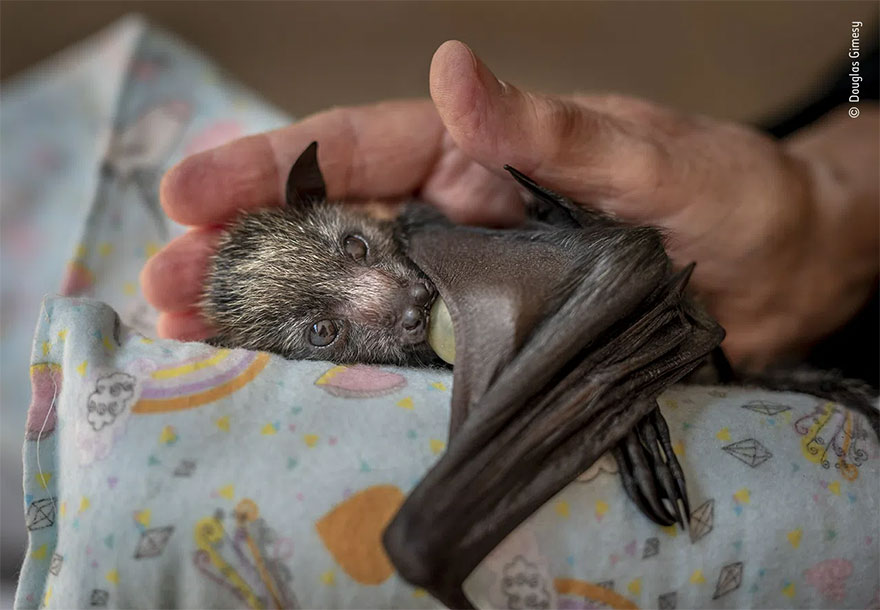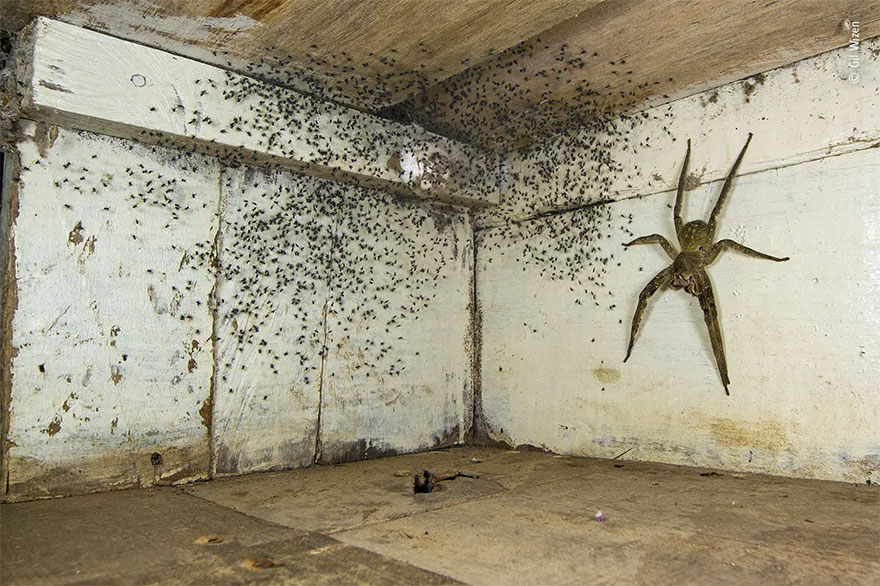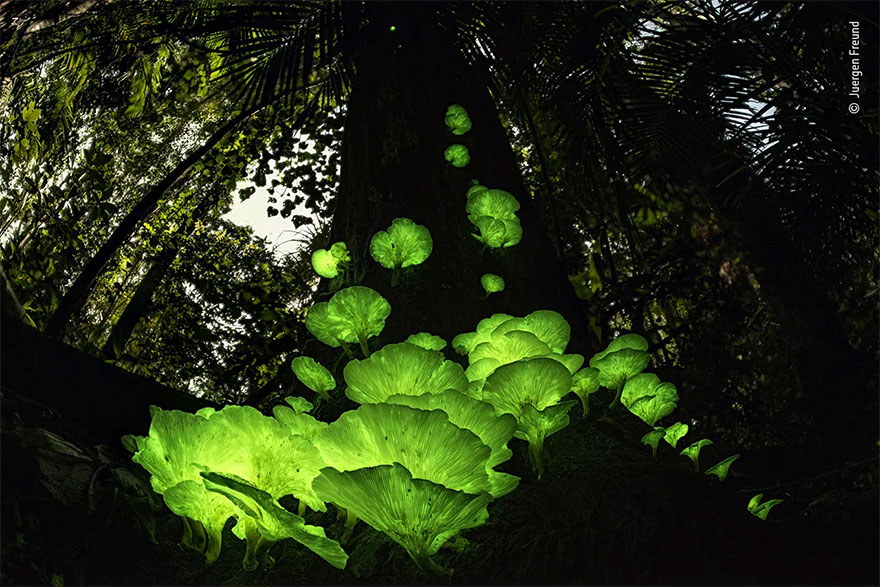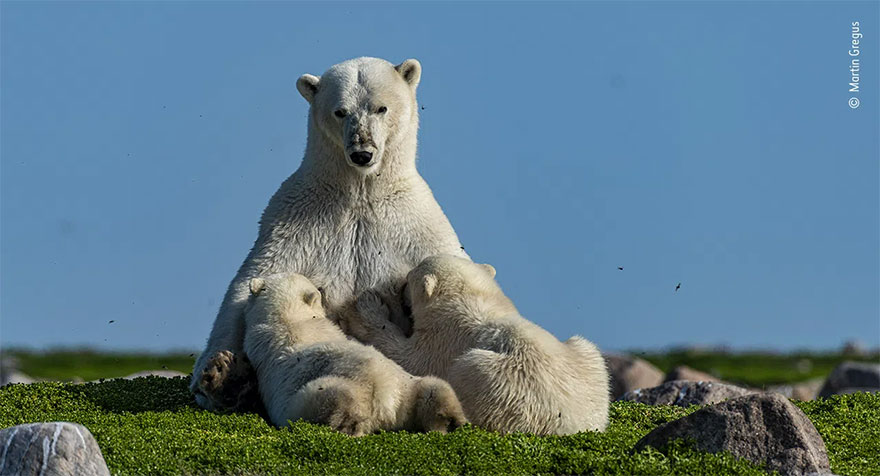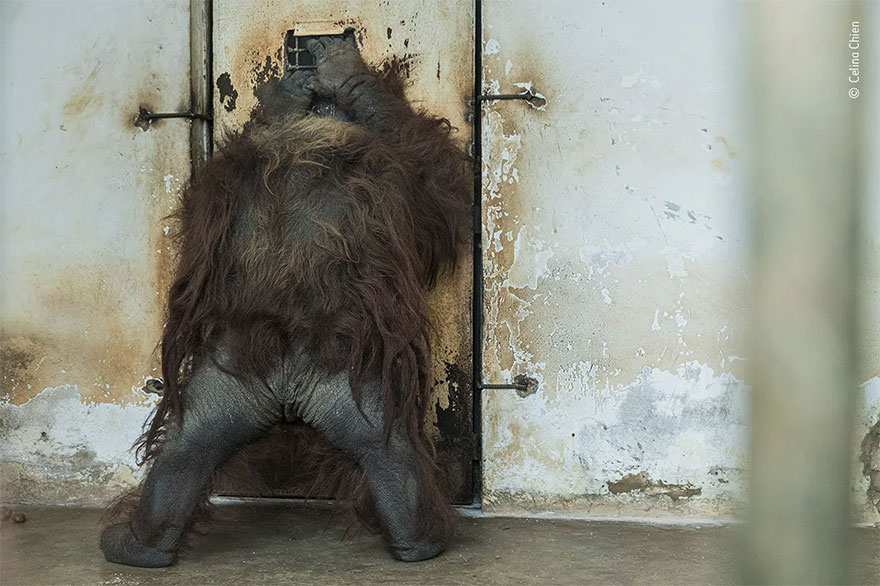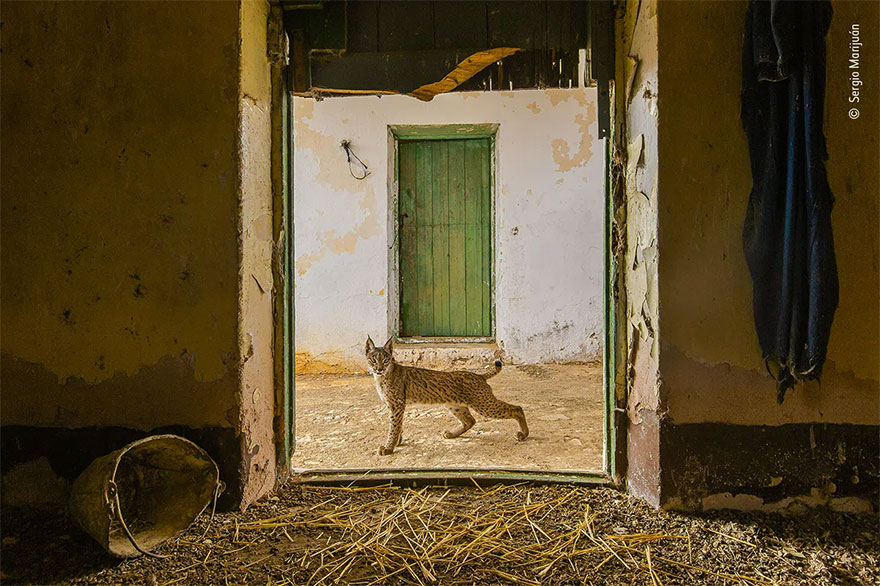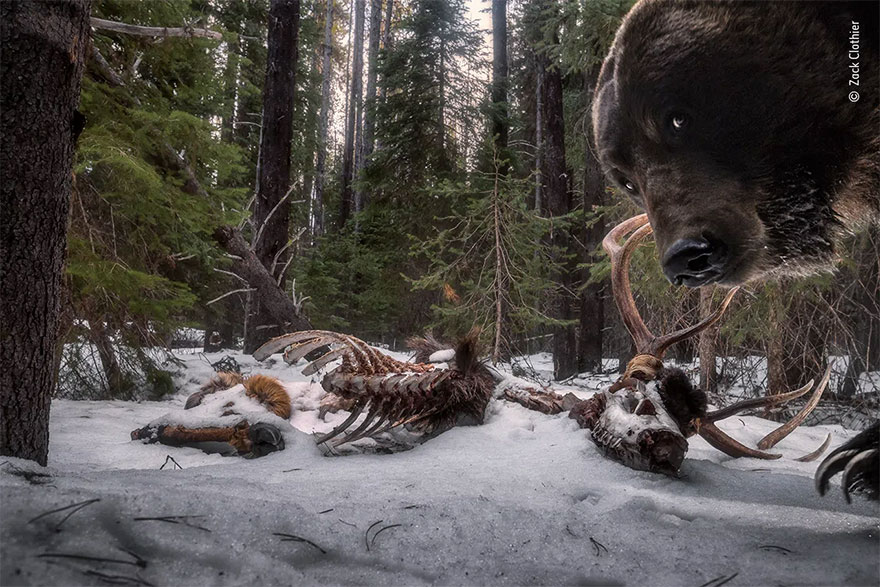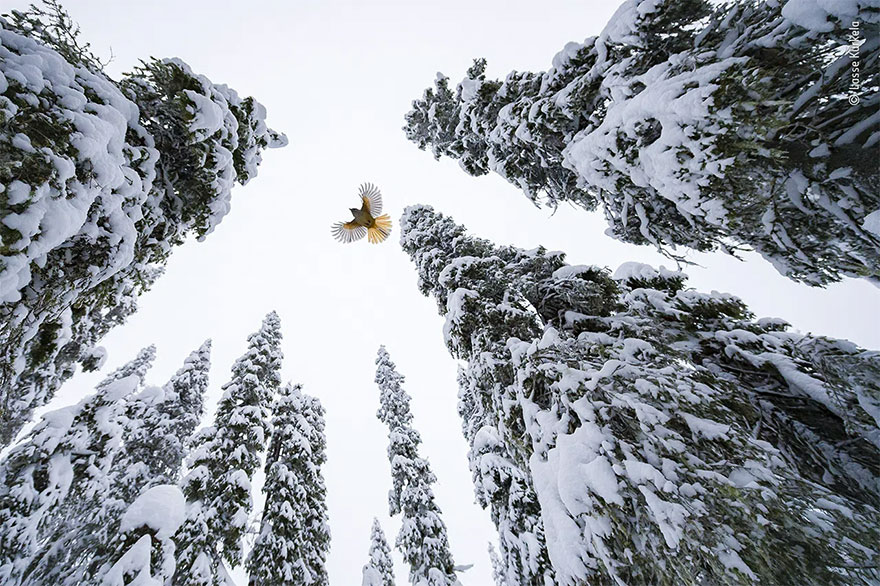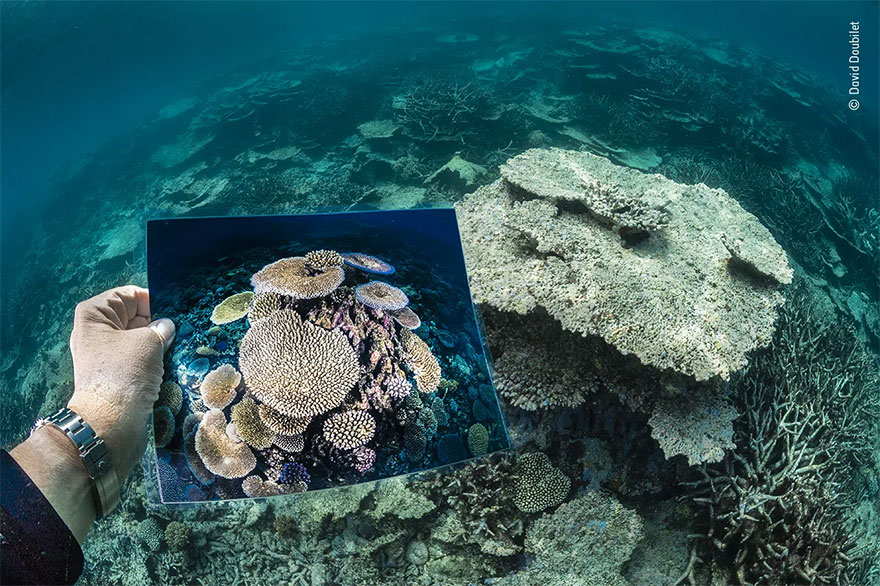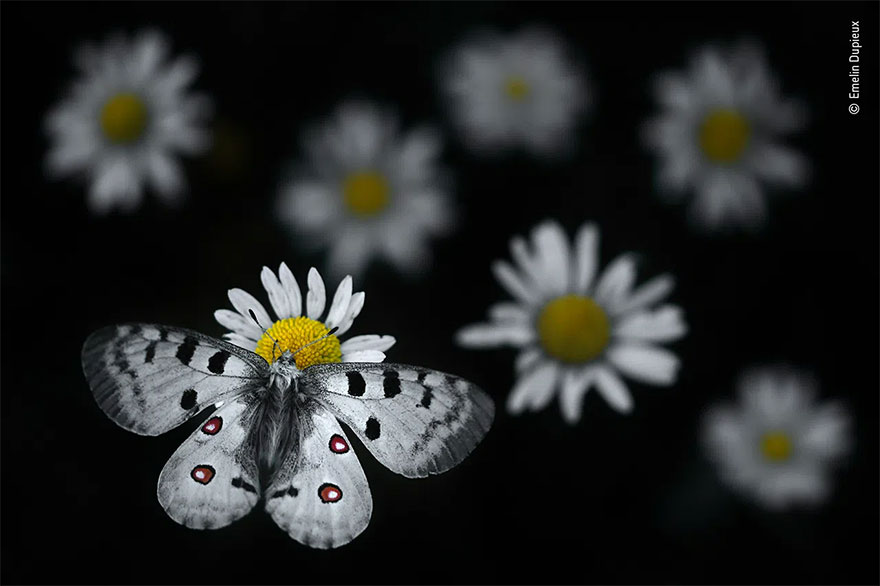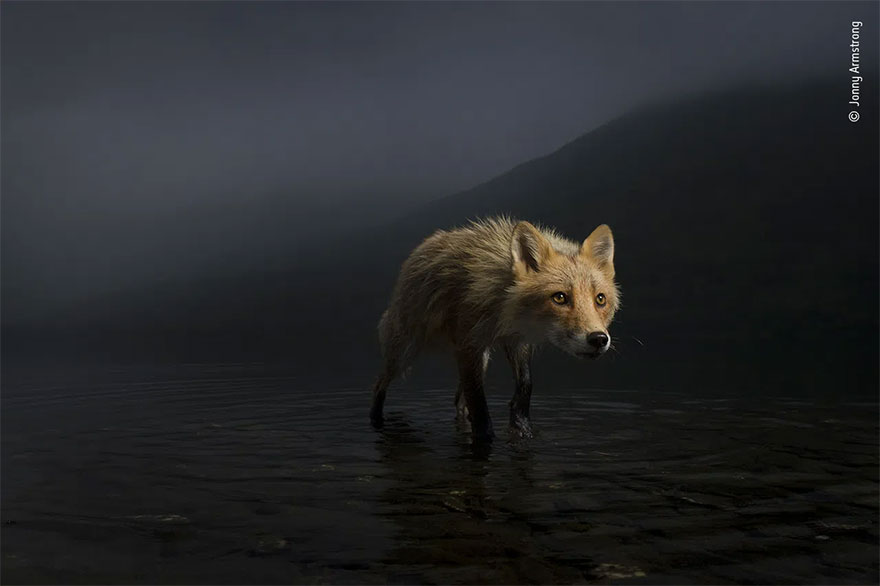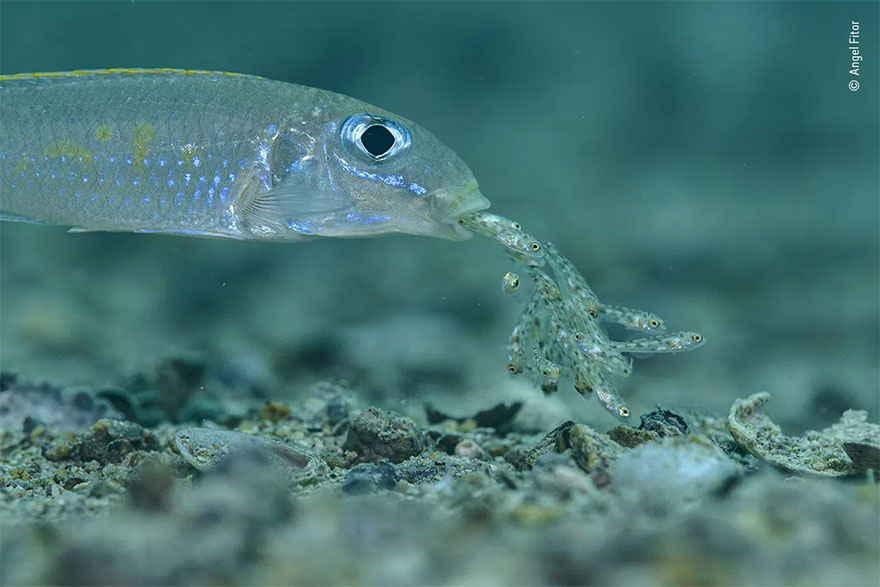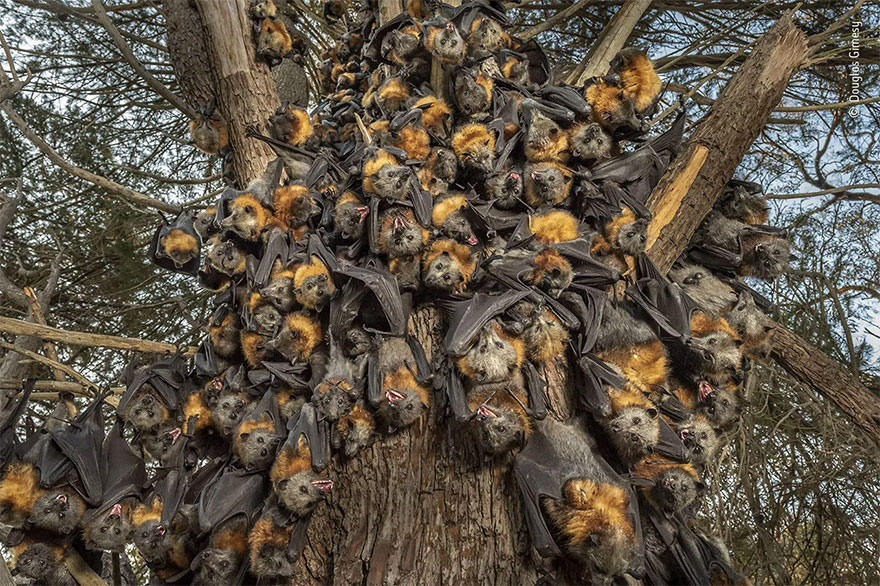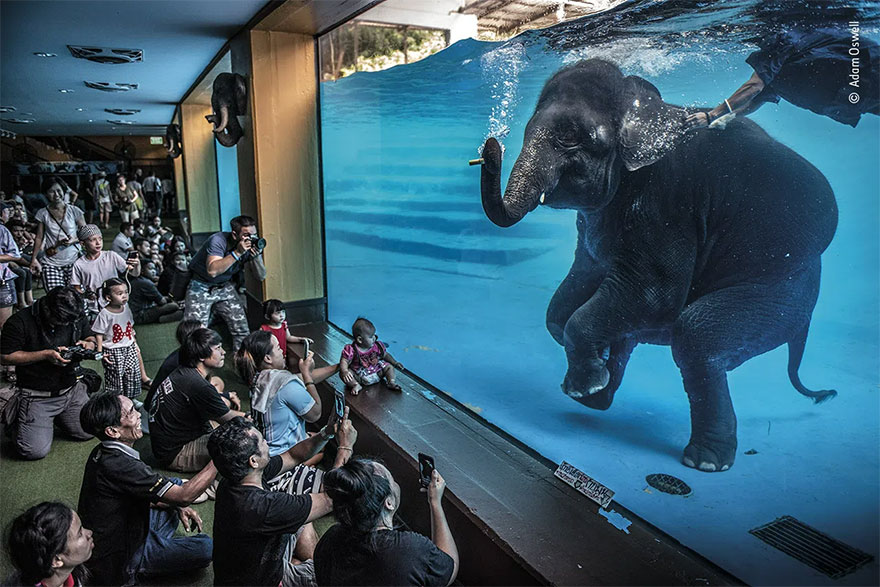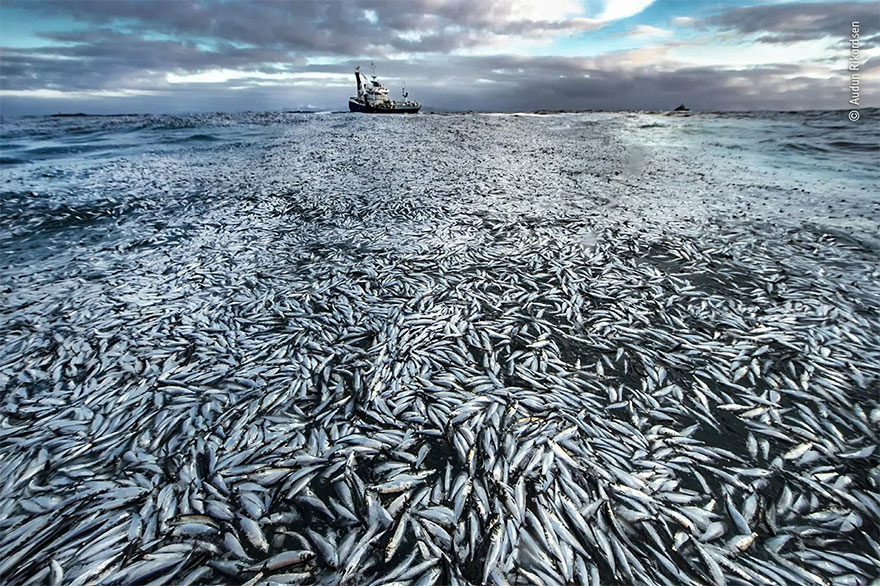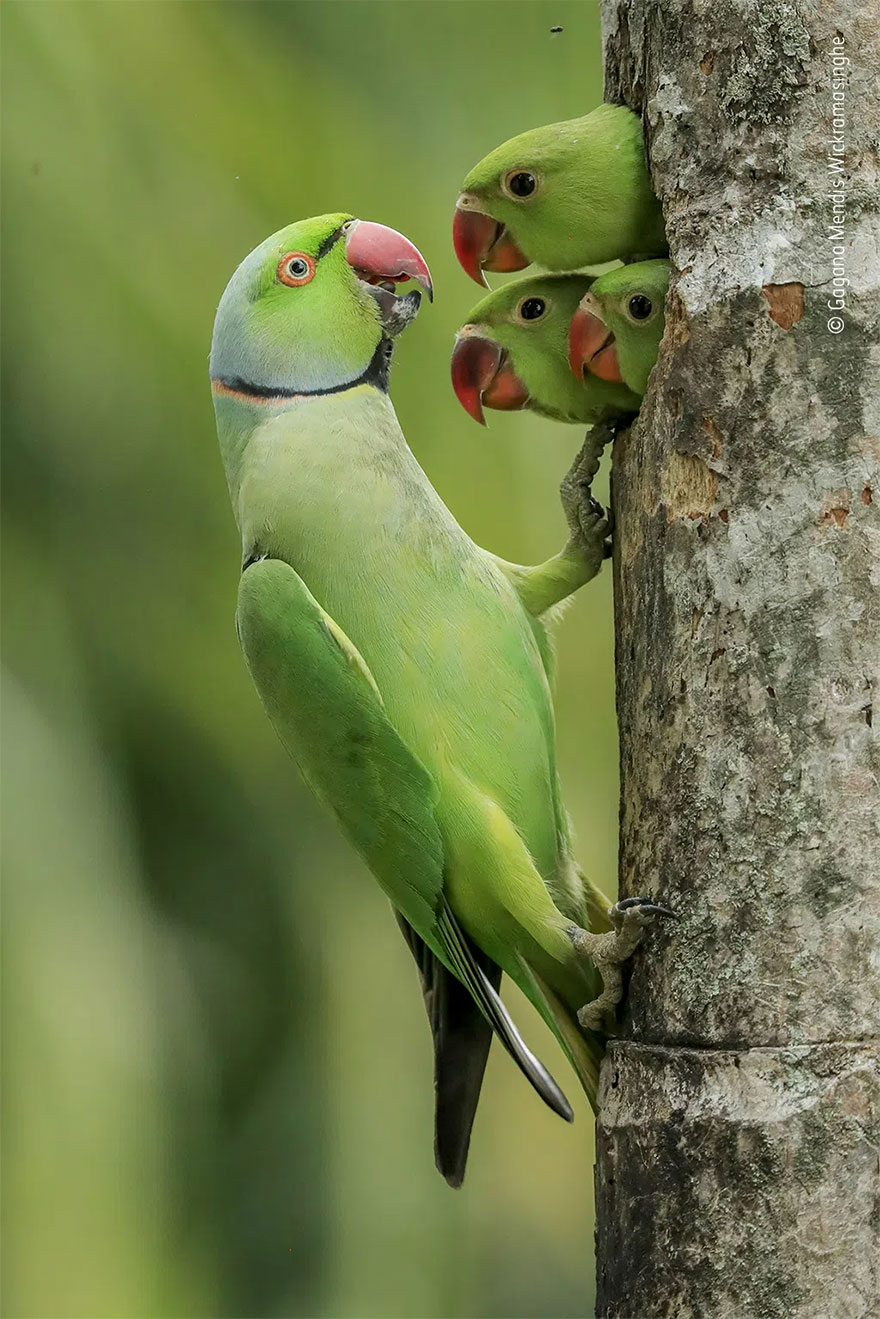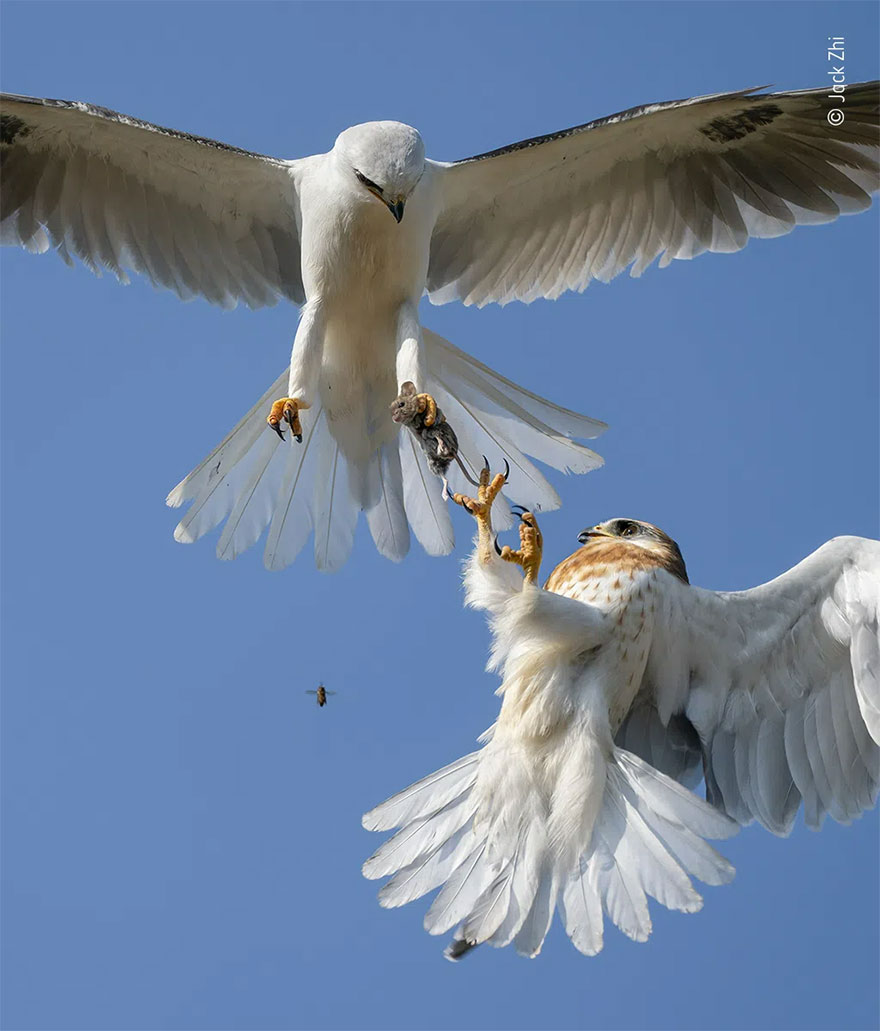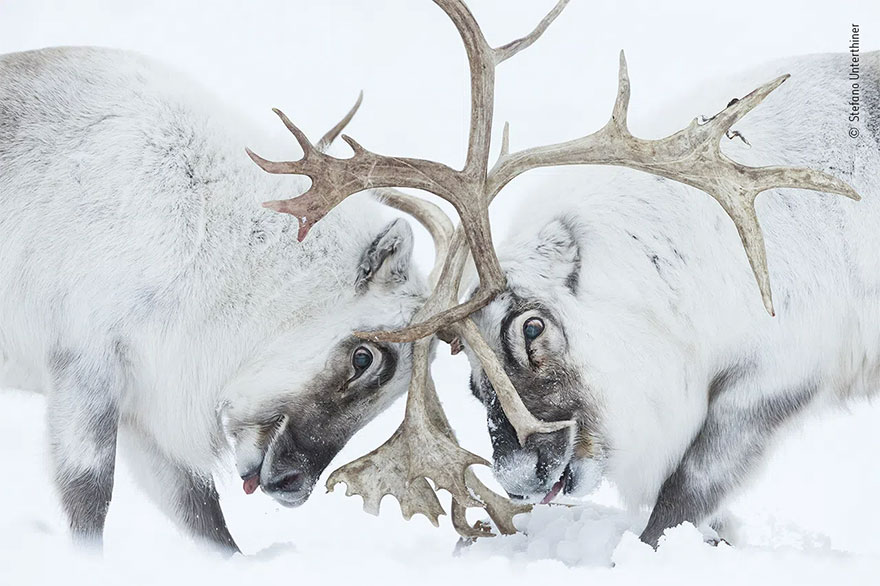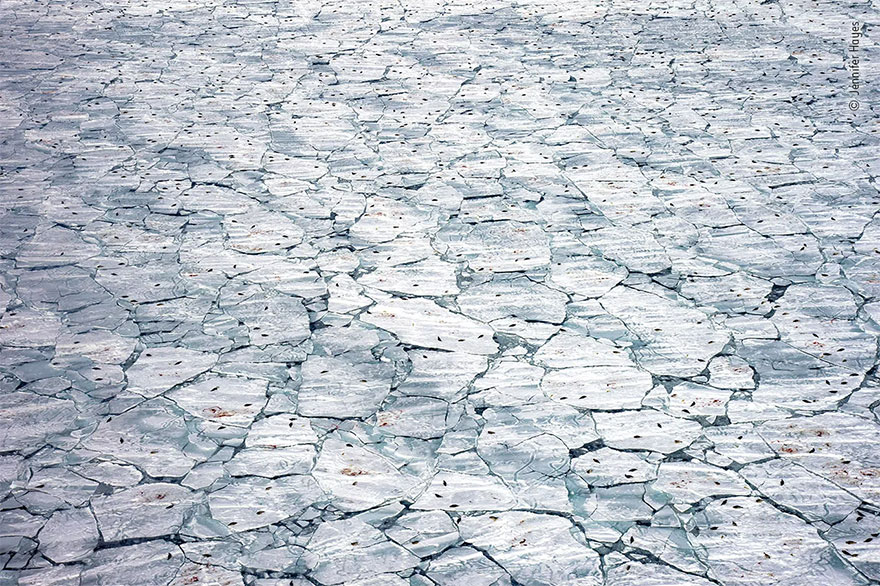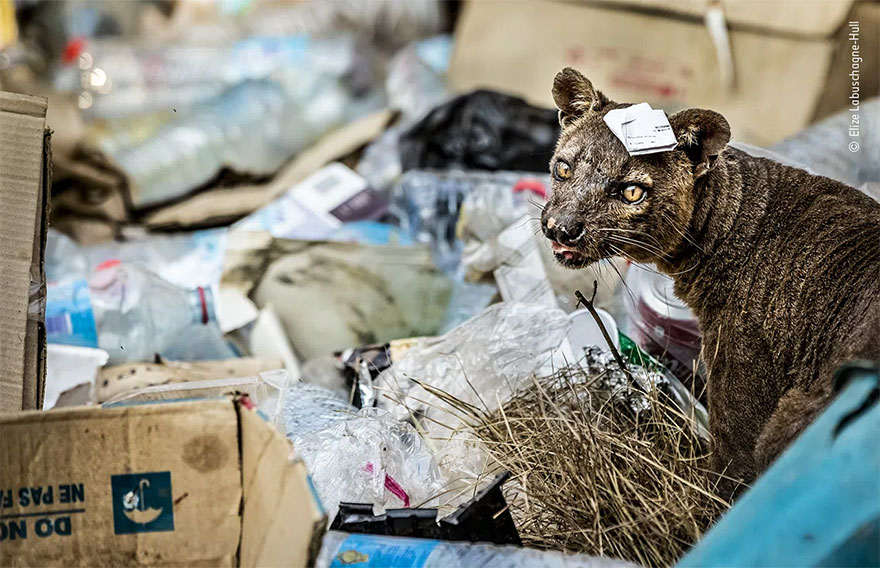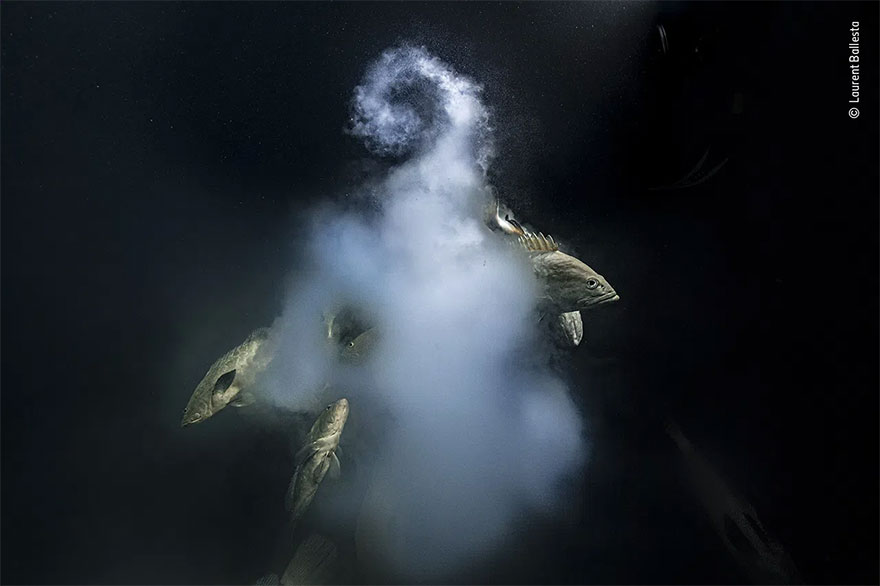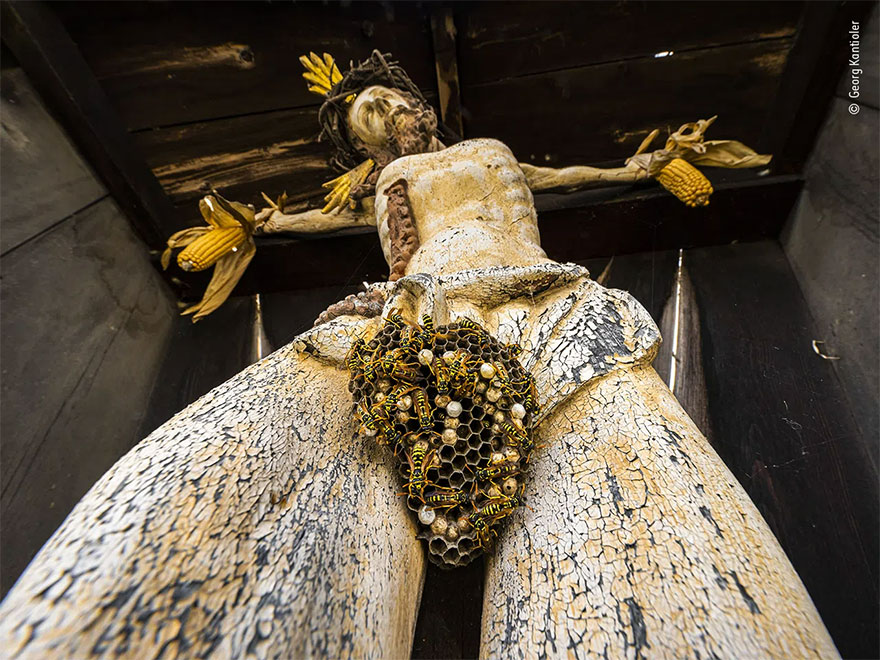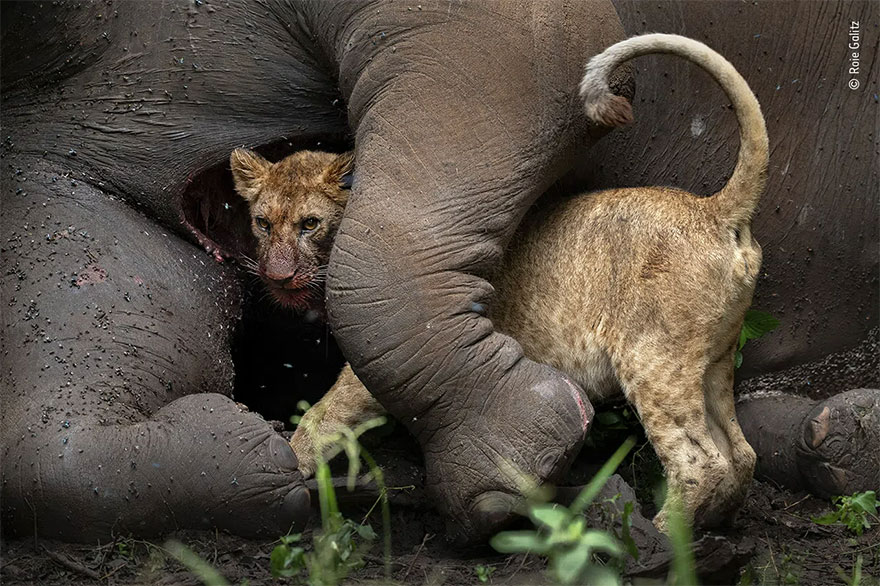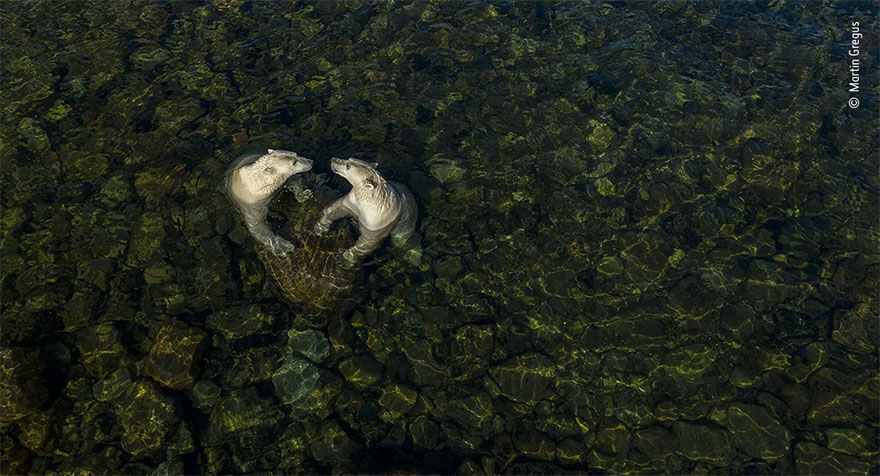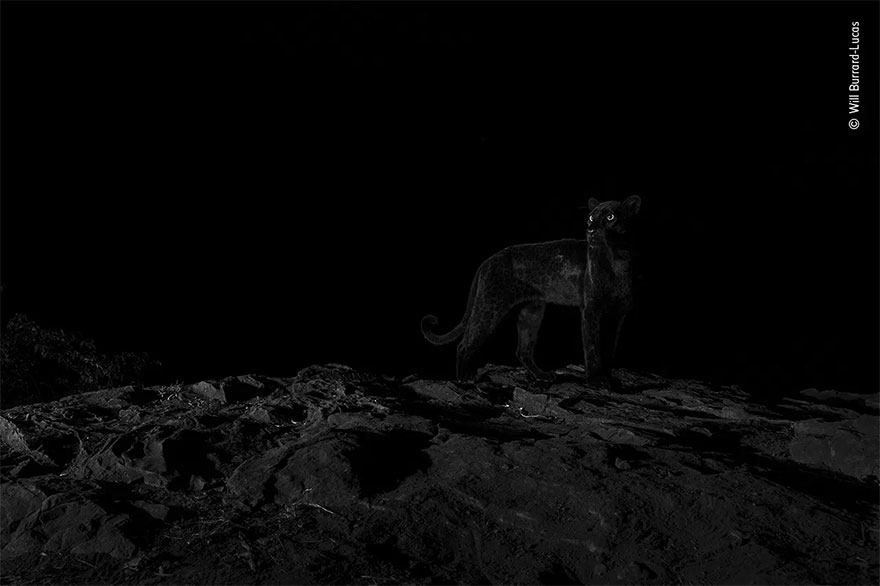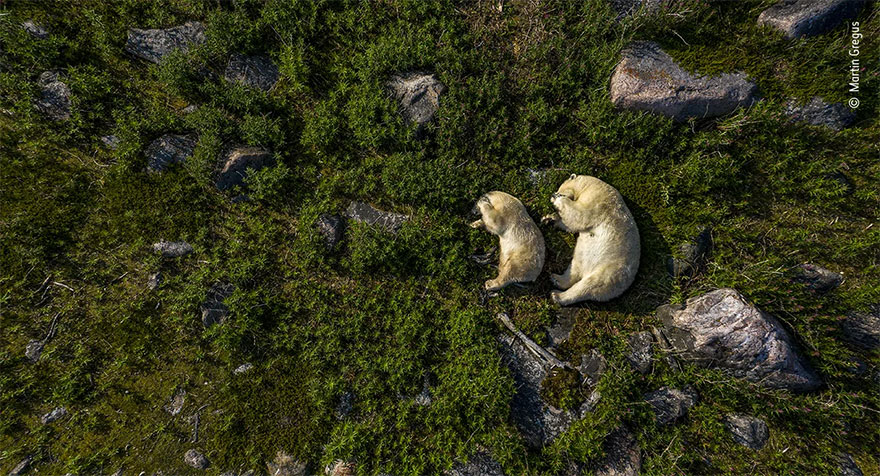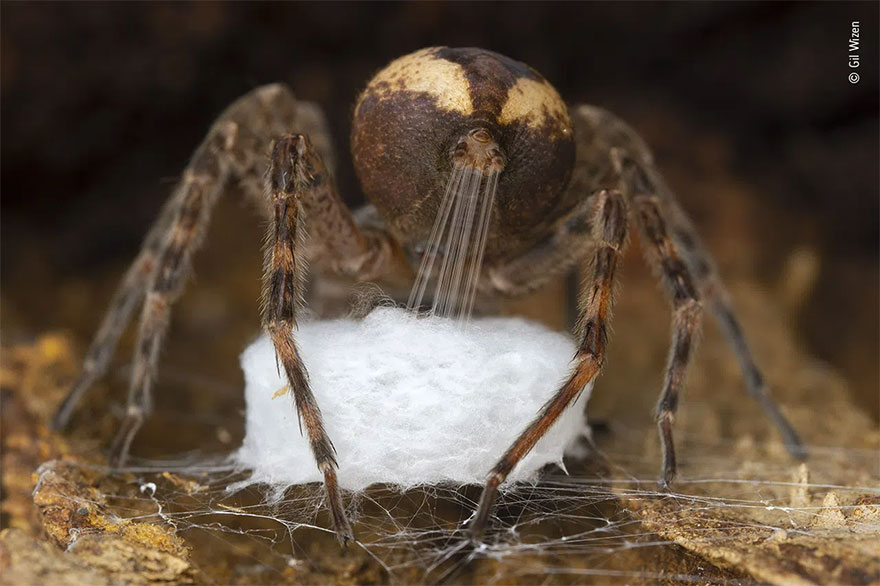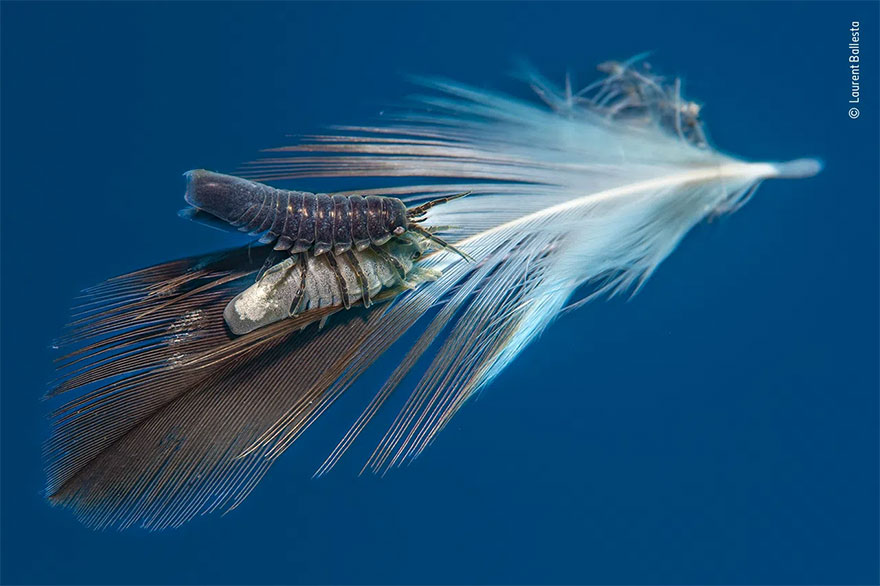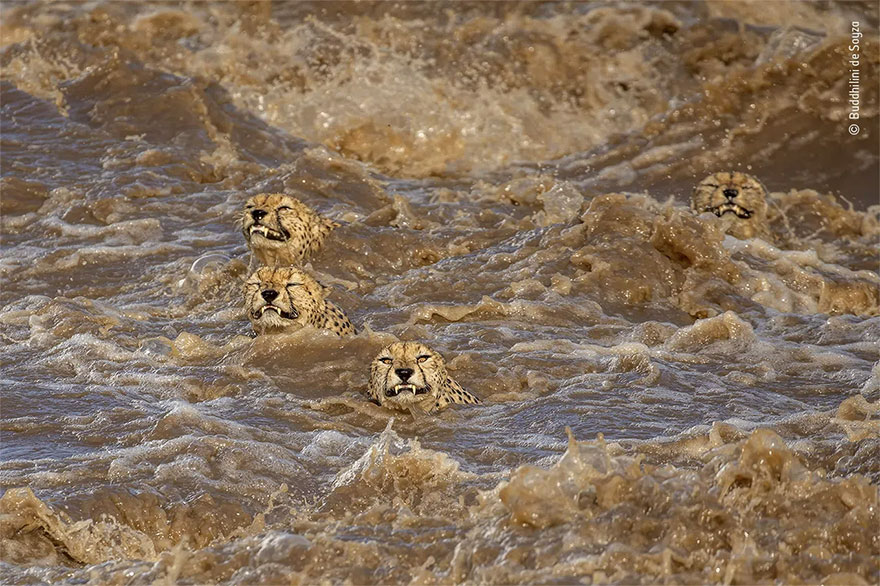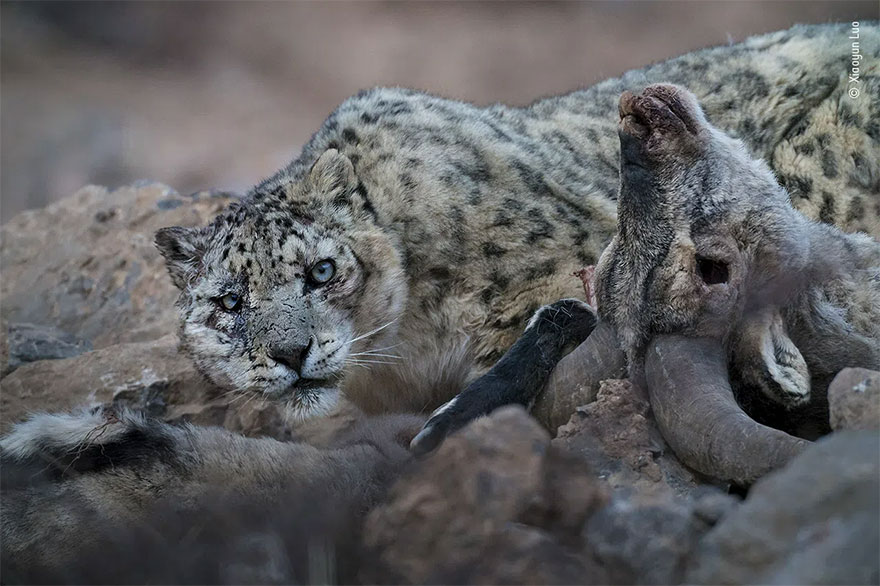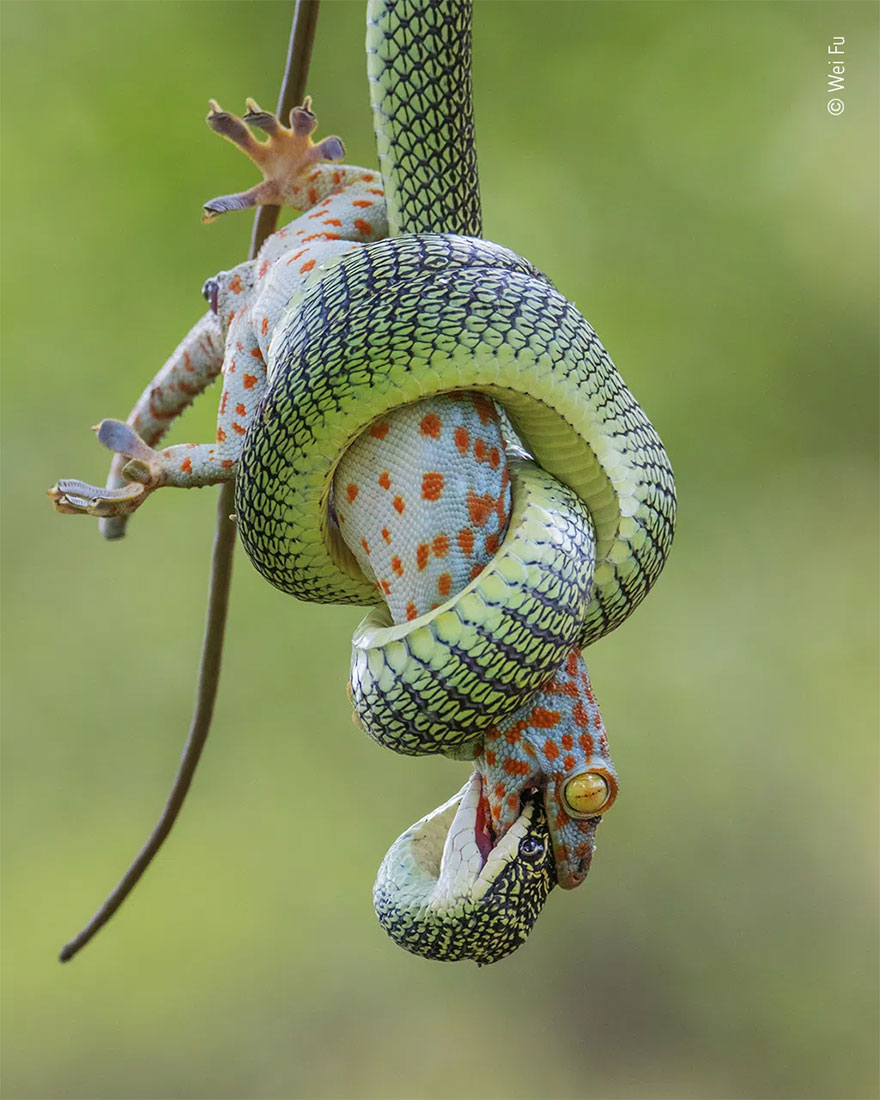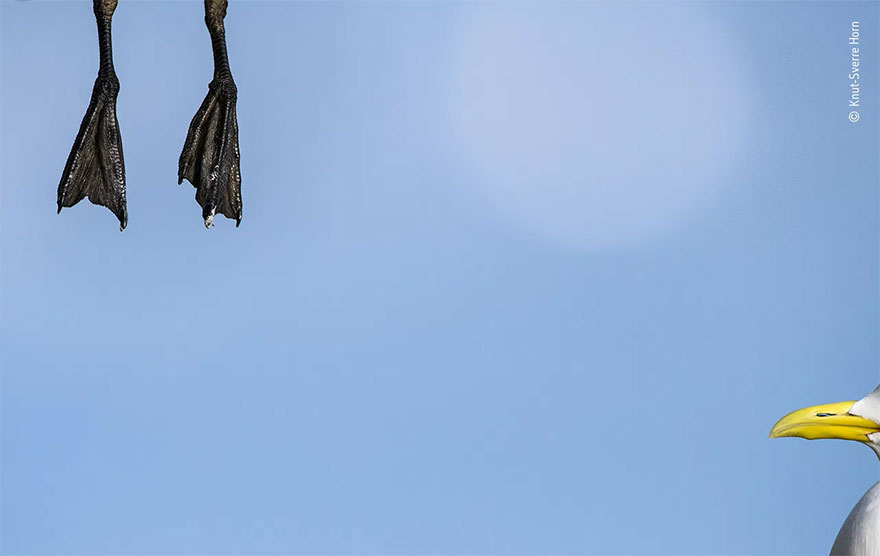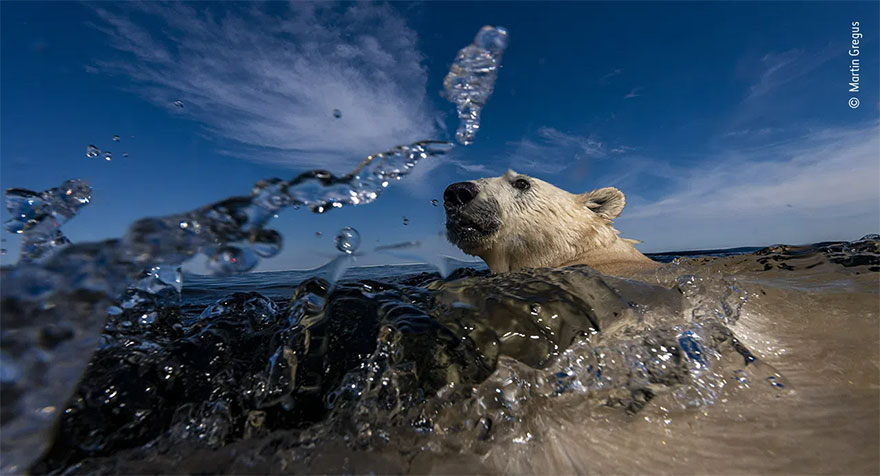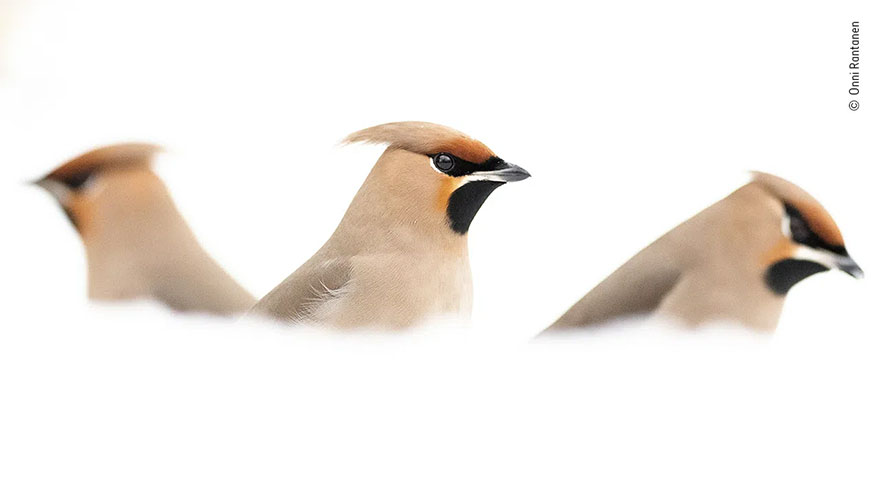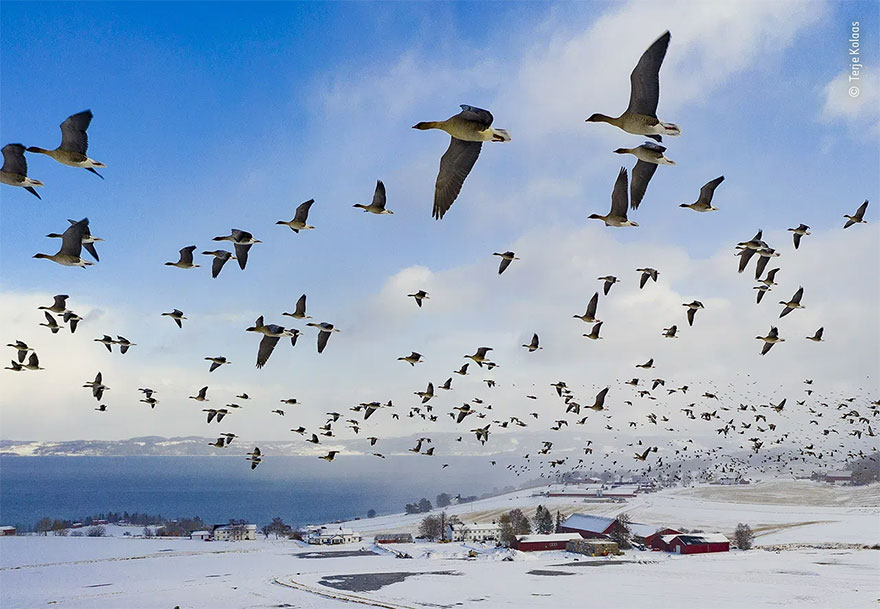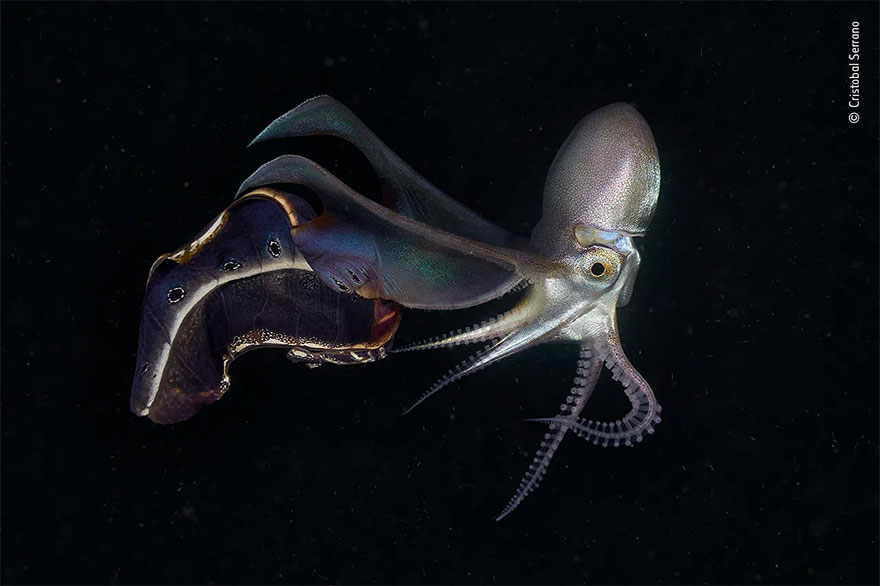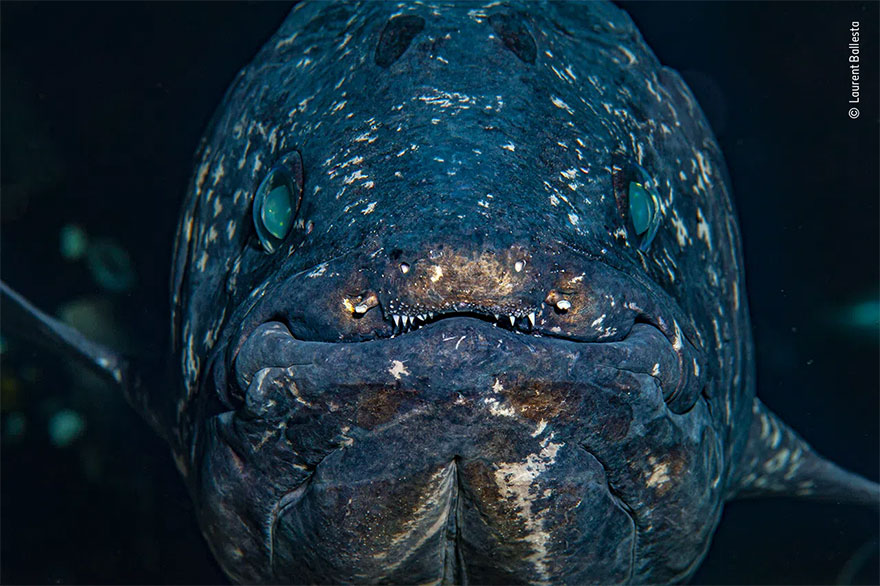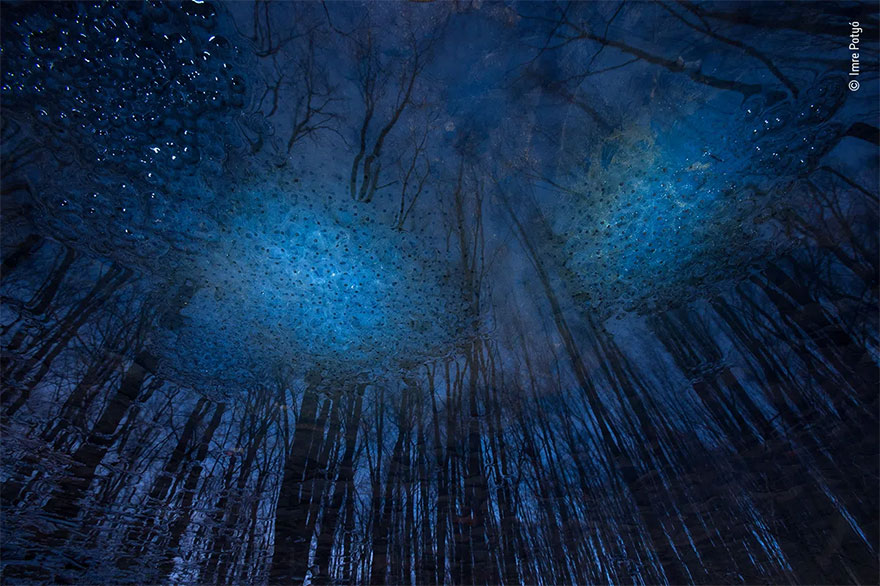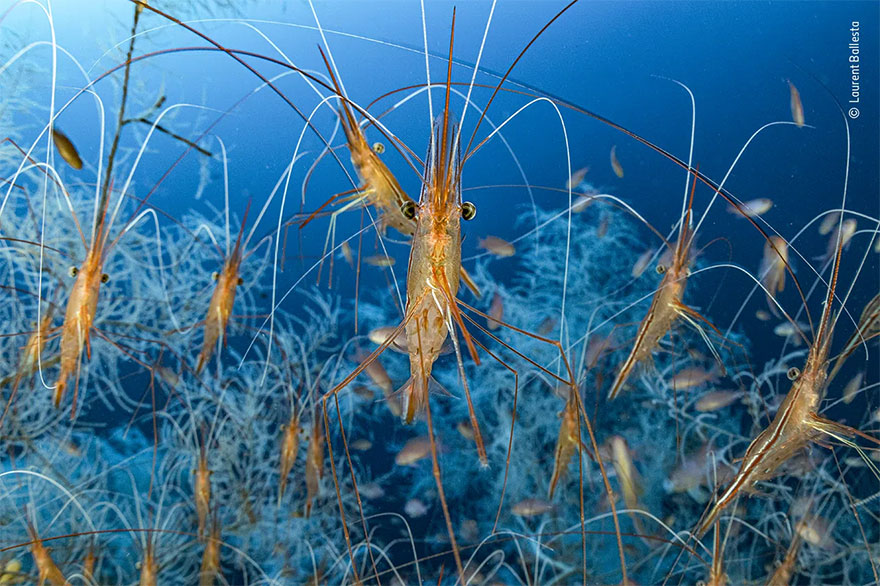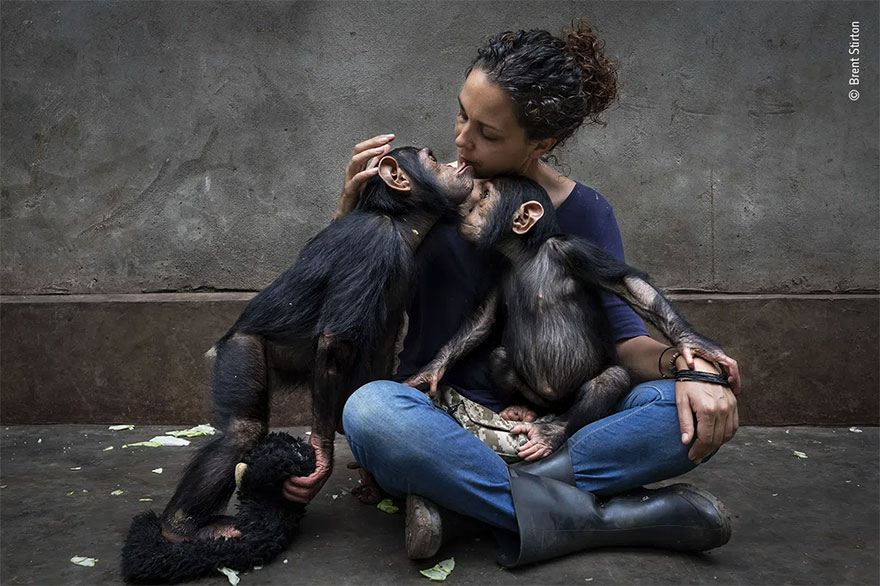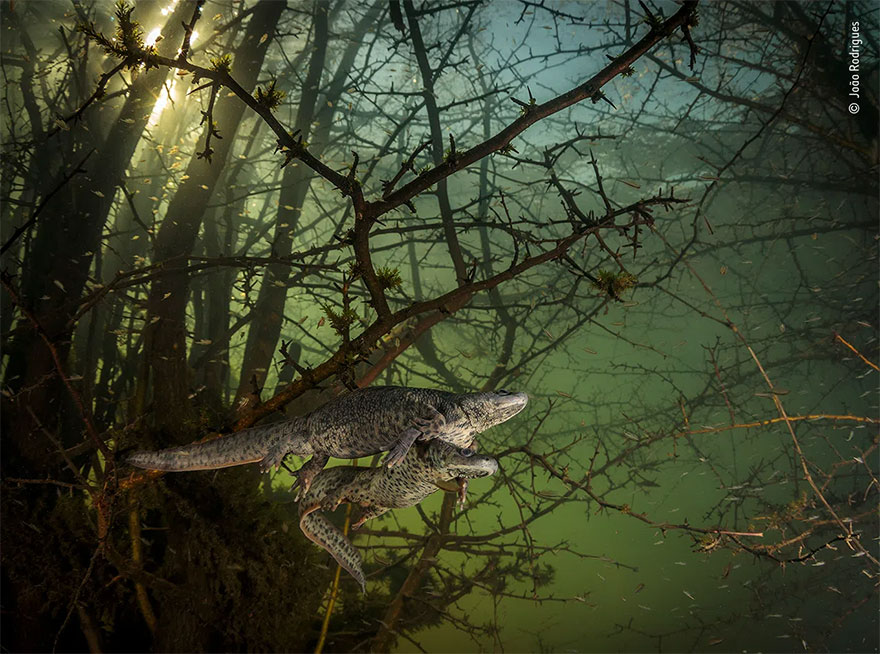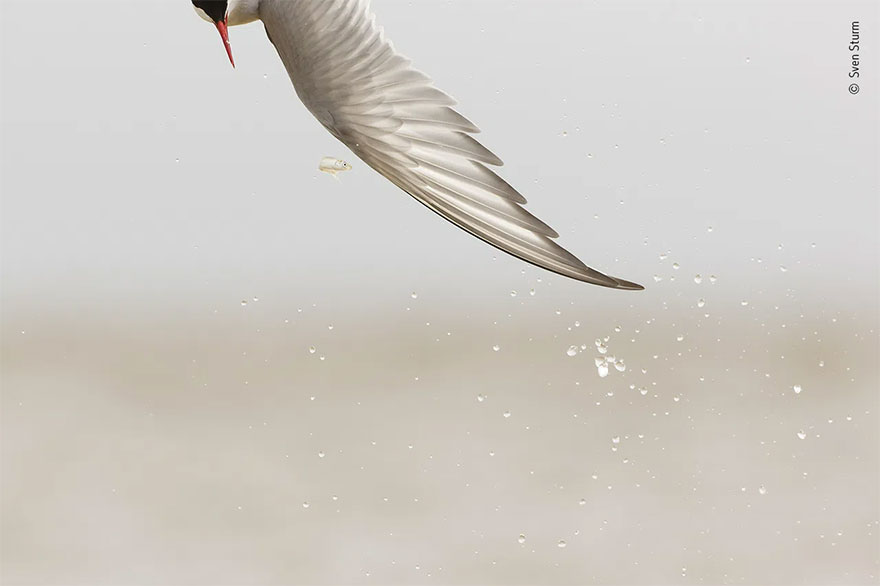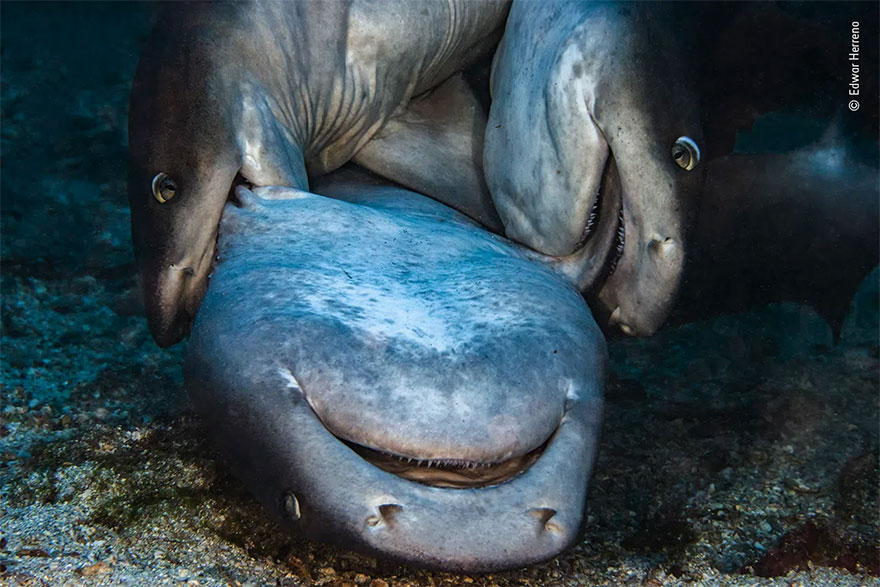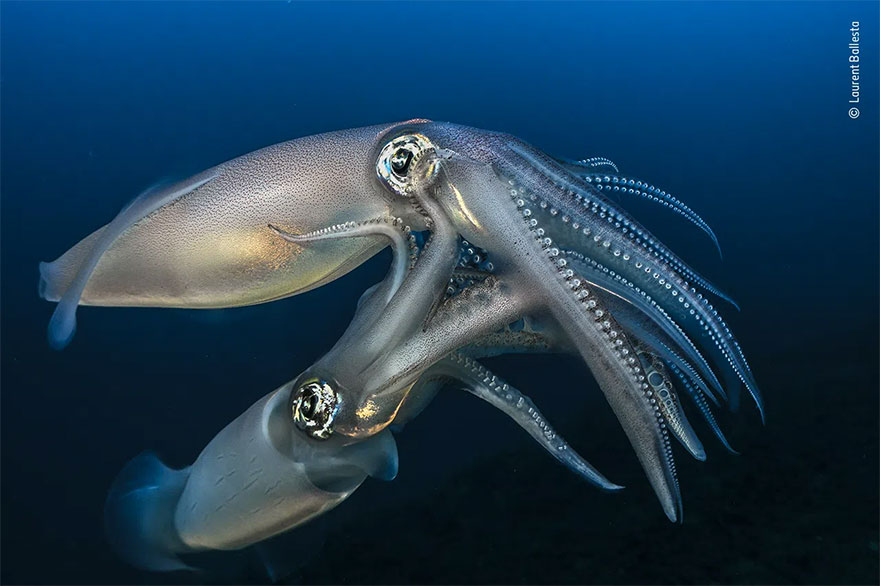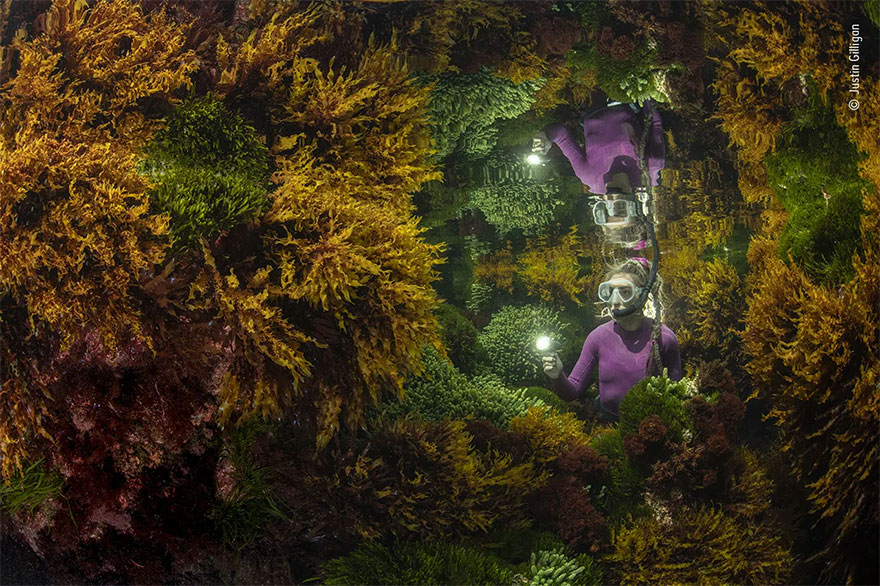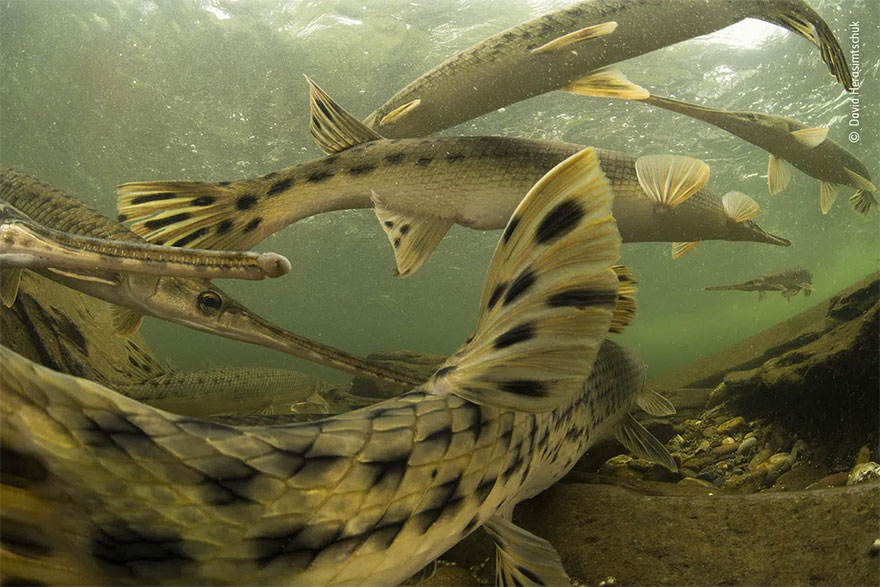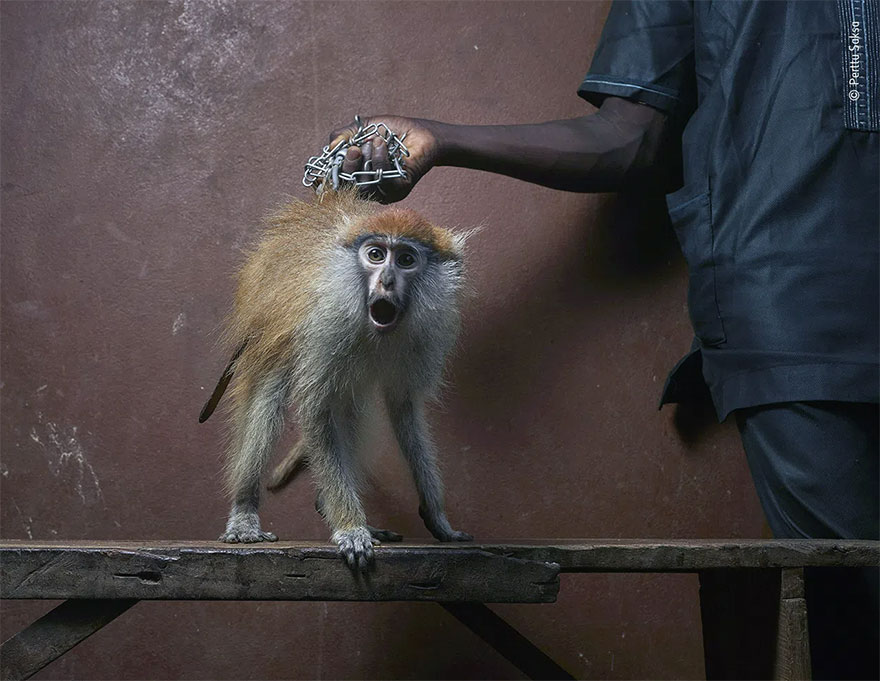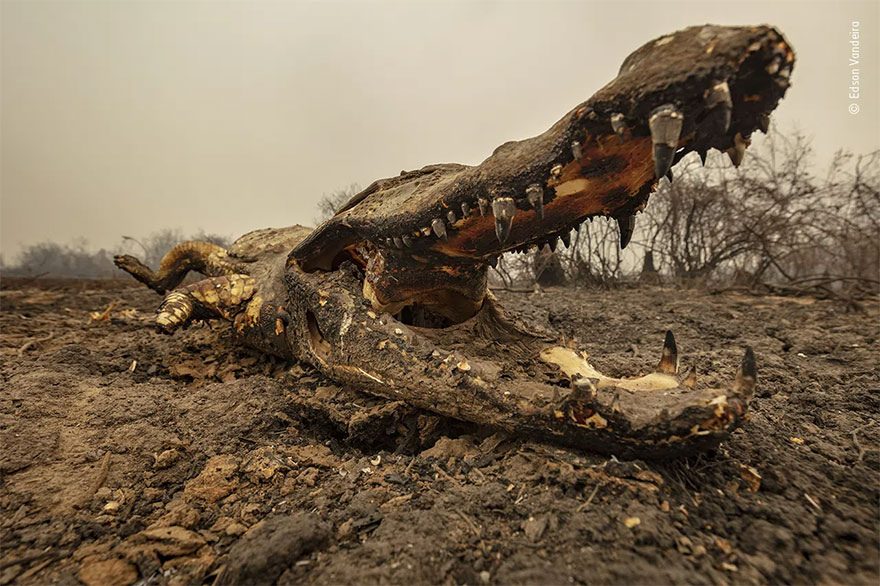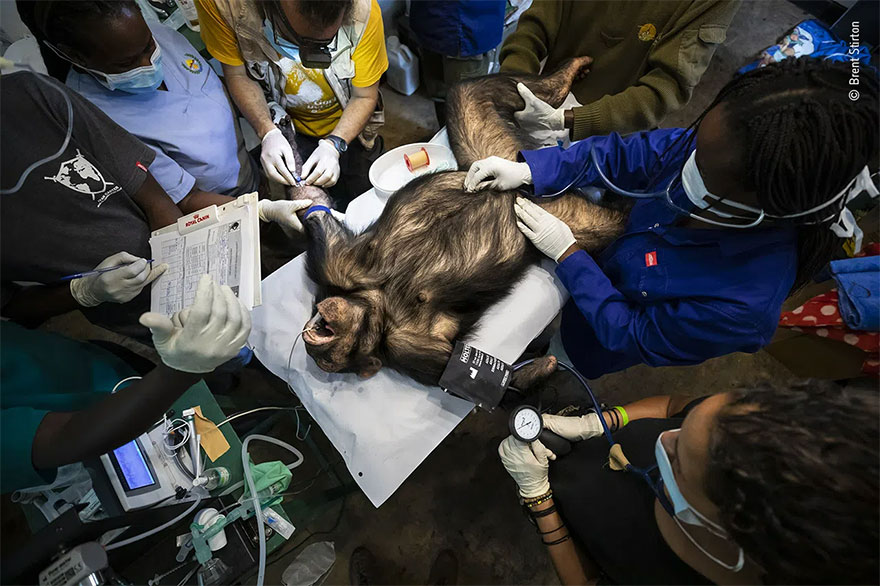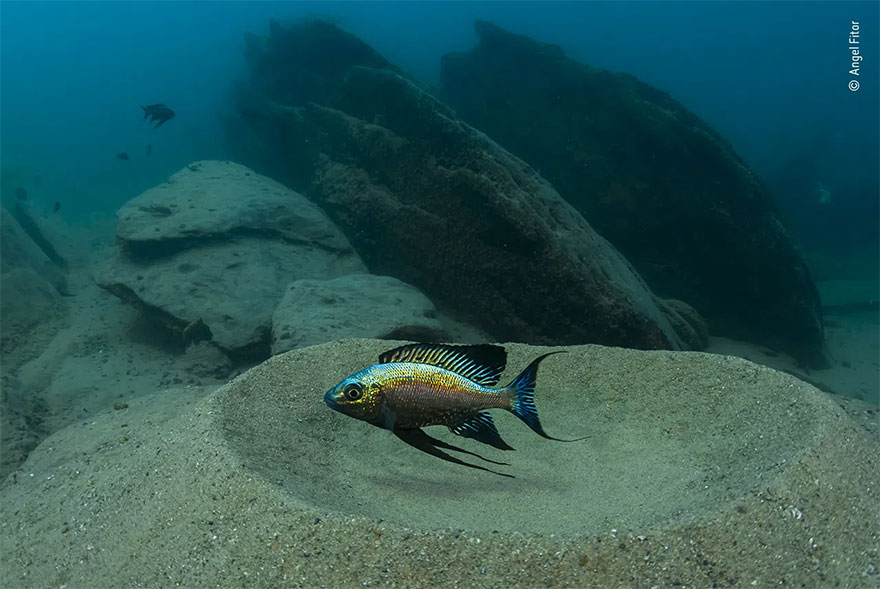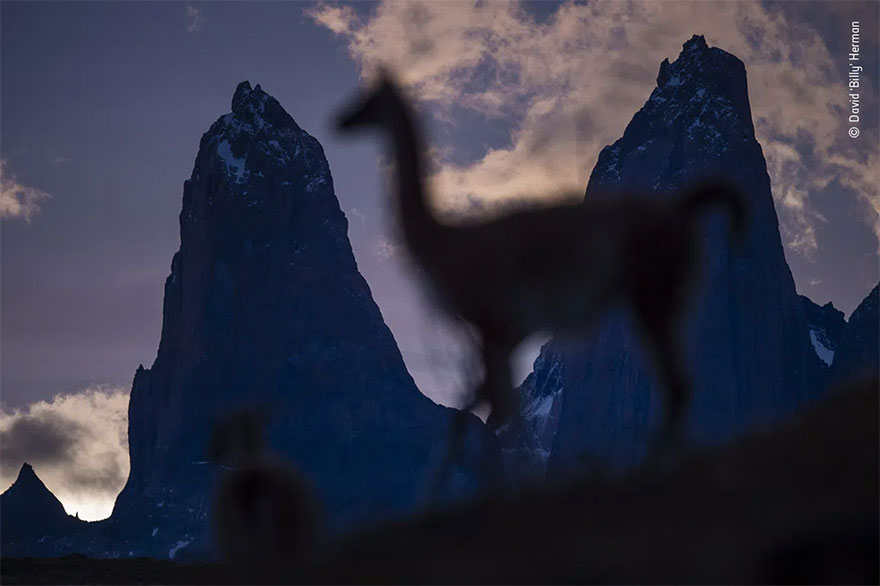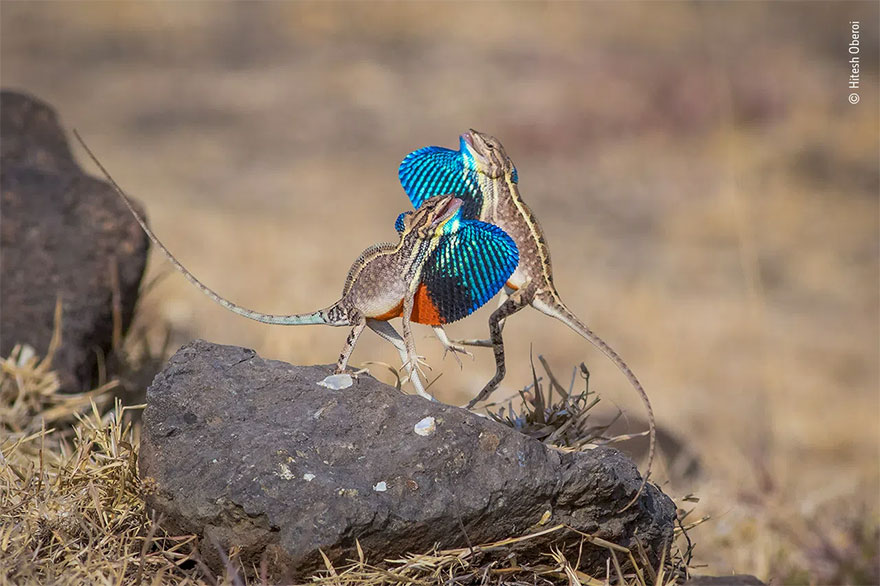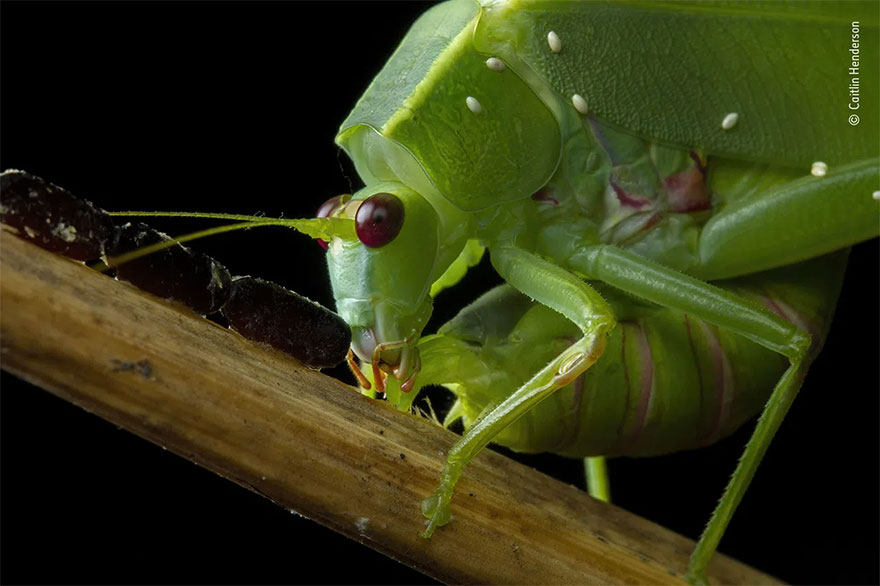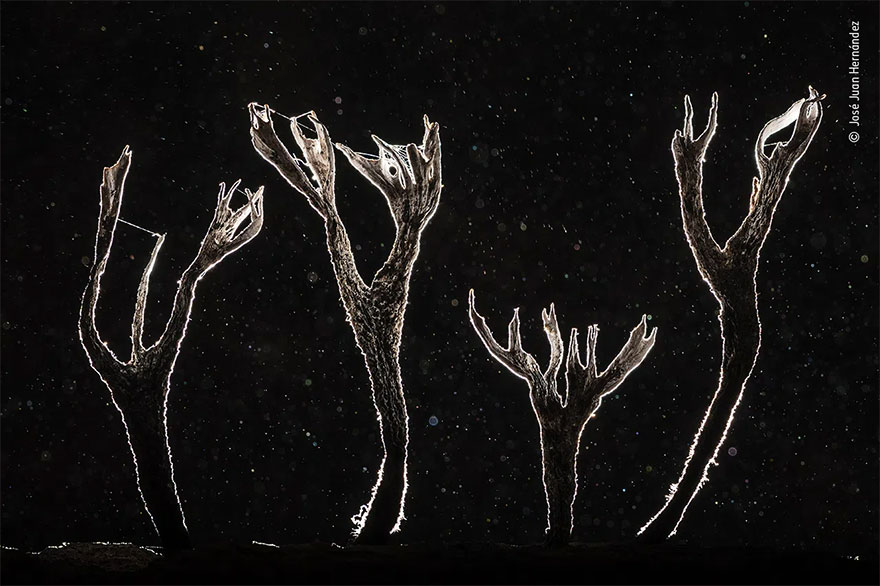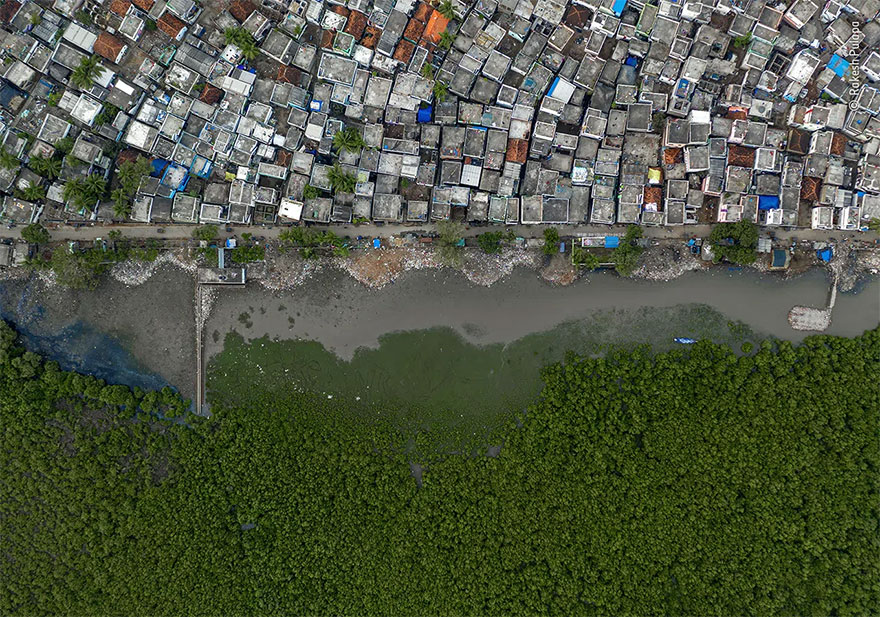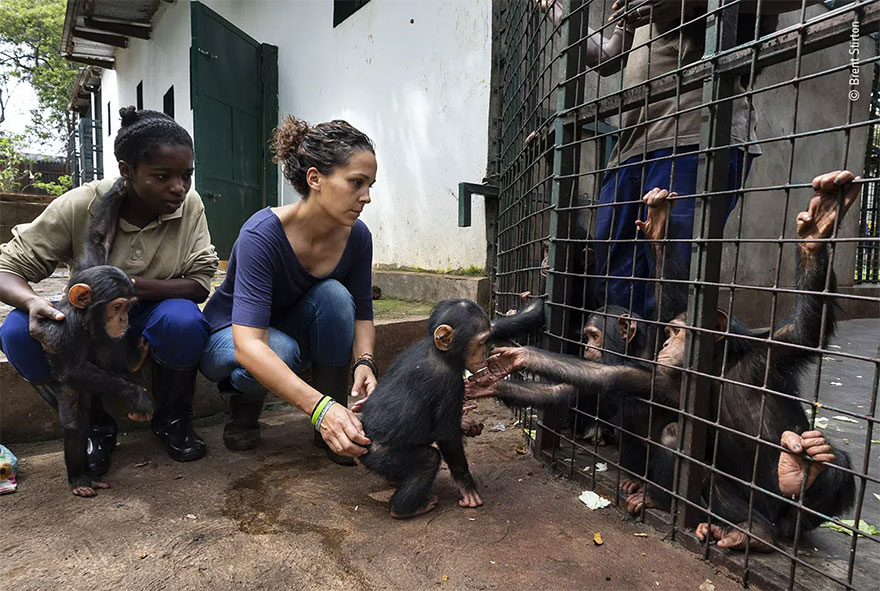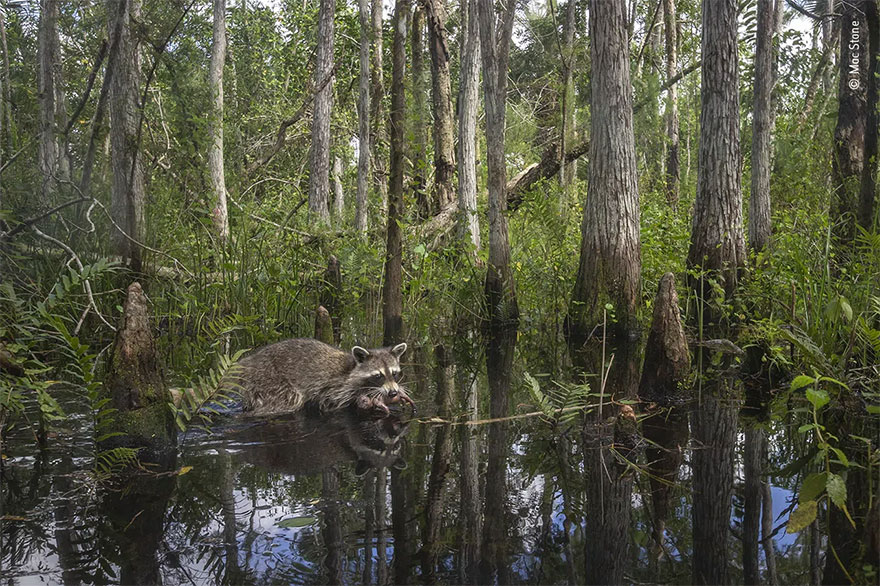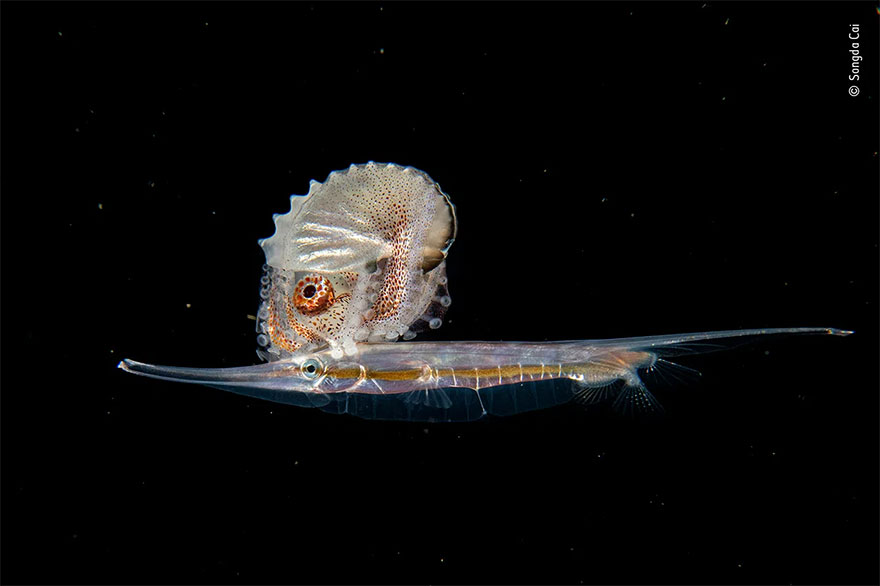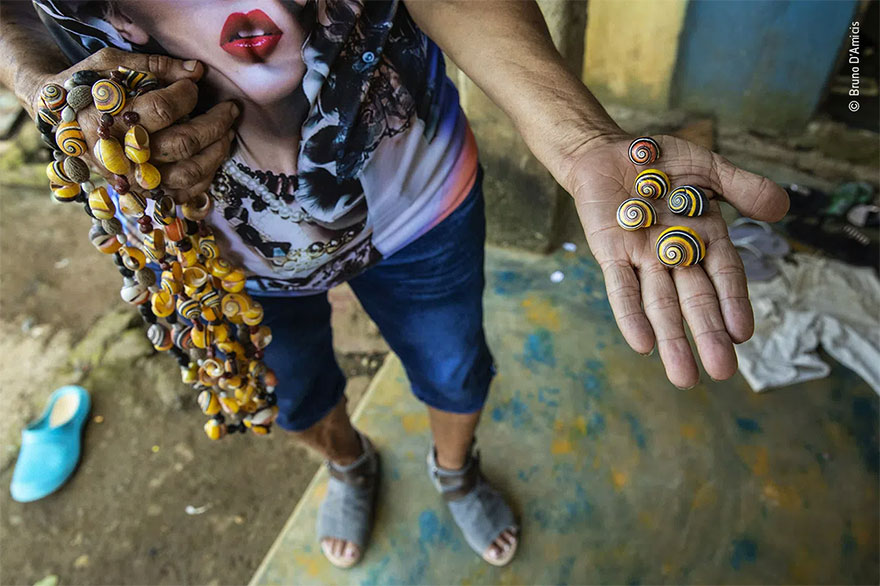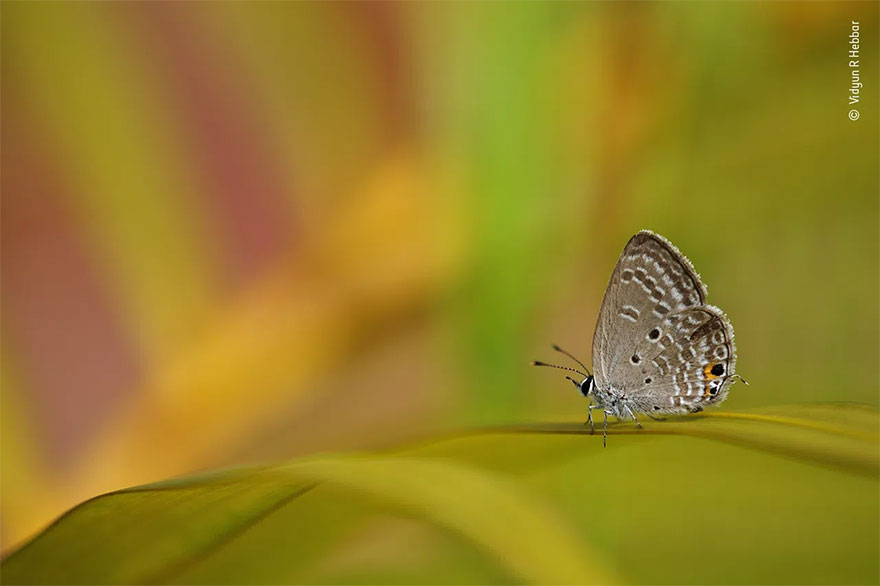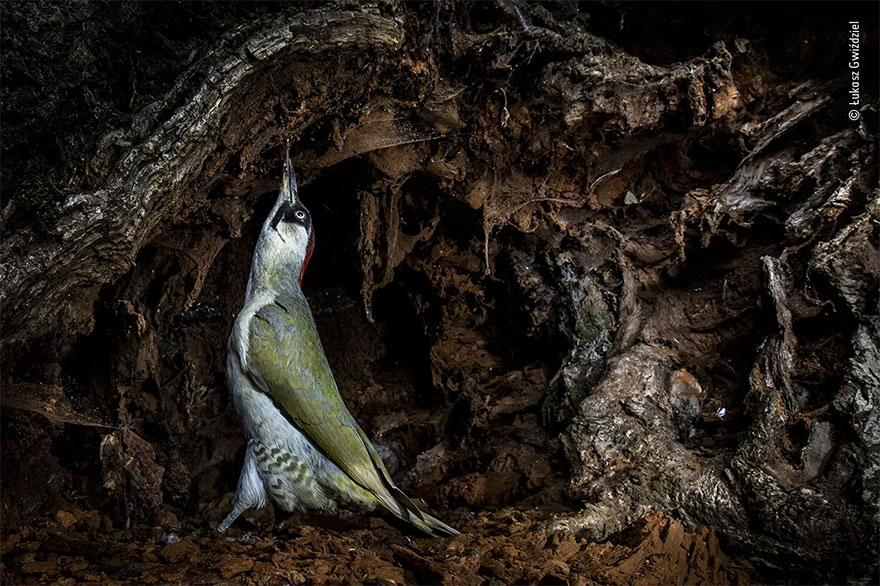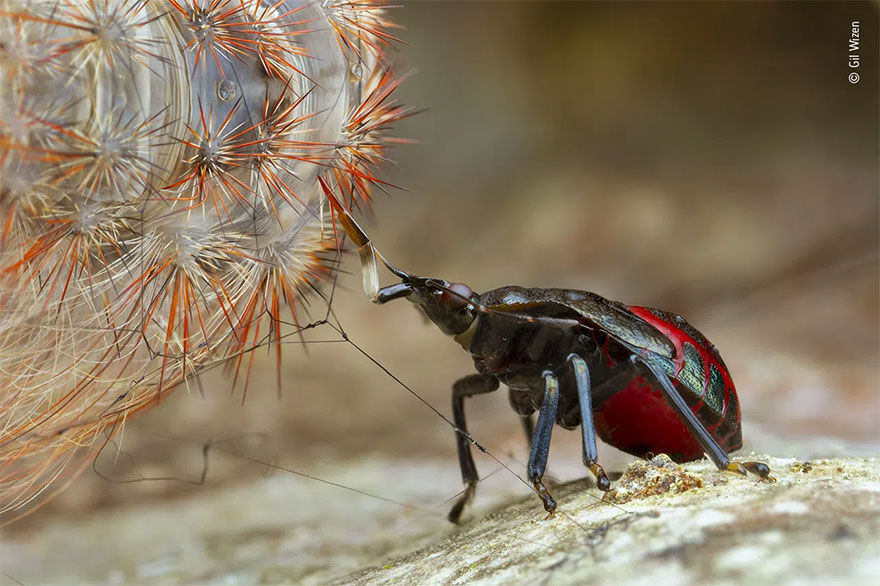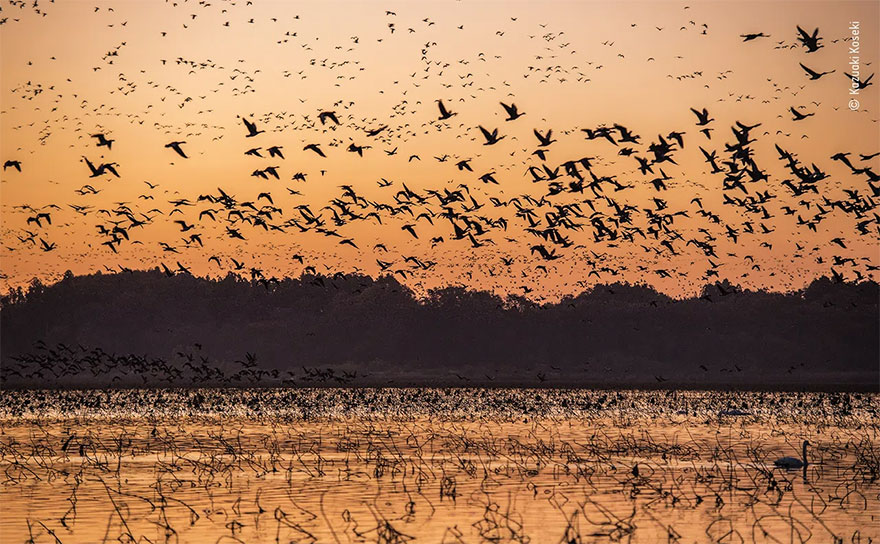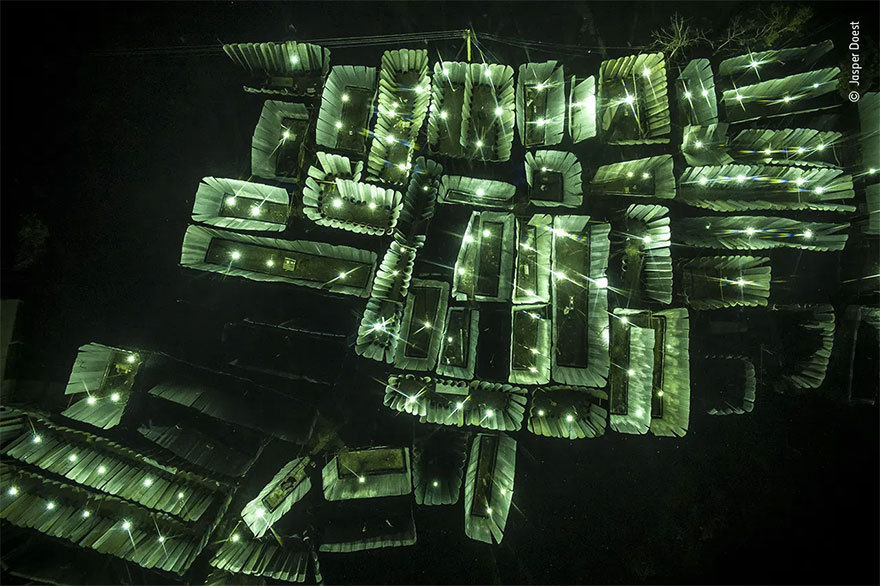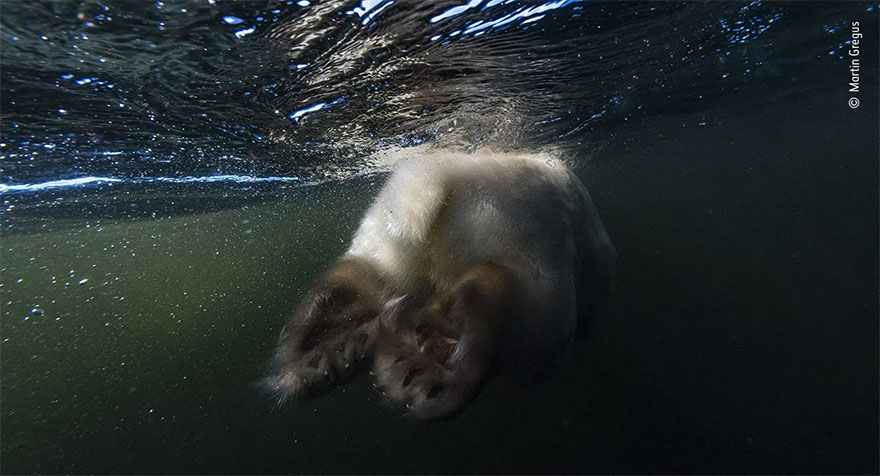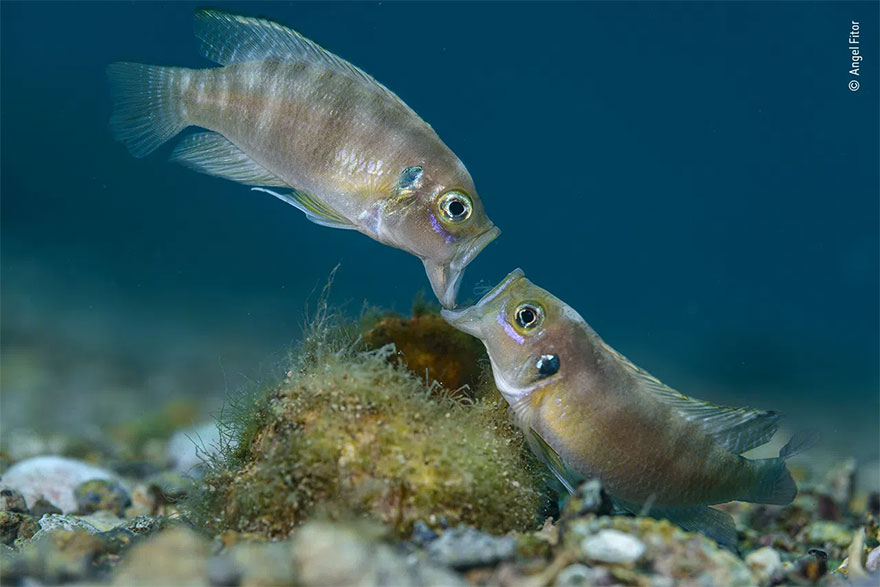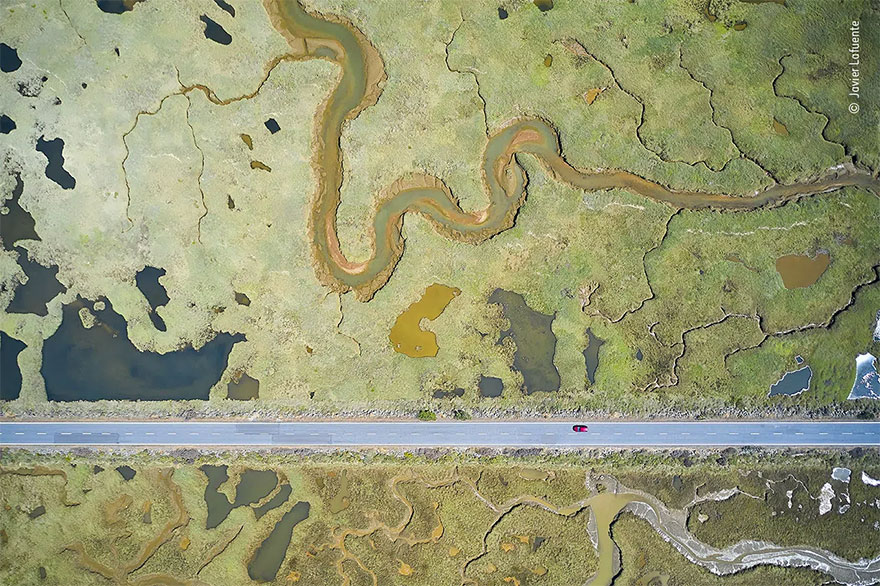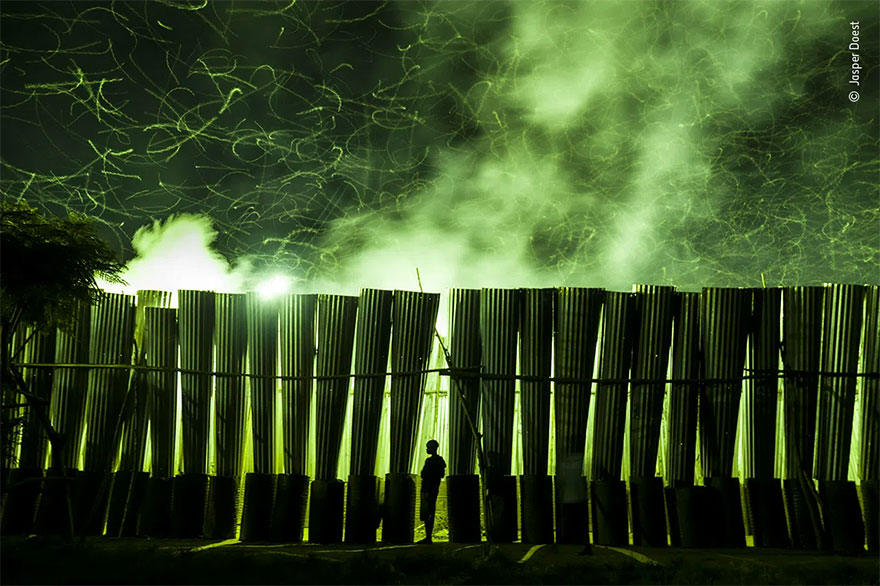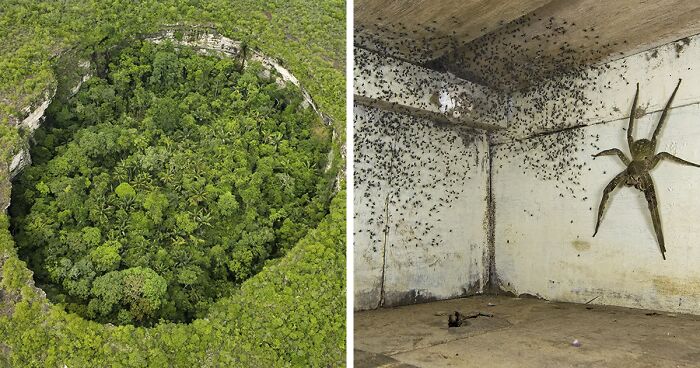
30 Stunning Winners From The 2021 Wildlife Photographer Of The Year That Have Just Been Announced
The Natural History Museum has just announced the winners of its Wildlife Photographer of the Year competition, and the images are as stunning as always.
The 57th edition of the contest saw 50,000 entries from 95 countries chasing the prize, with shots ranging from a reindeer battle to a venomous spider hiding under a bed.
However, it was the French underwater photographer and biologist Laurent Ballesta who was crowned this year's Wildlife Photographer of the Year for his enigmatic picture, Creation, that captures camouflage groupers exiting their milky cloud of eggs and sperm in Fakarava, French Polynesia.
Every year, for five years, Laurent and his team returned to this lagoon, diving day and night so as not to miss the annual spawning that is so rare, it only takes place around the full moon in July. In total, Ballesta has spent around 3,000 hours trying to capture it.
Continue scrolling to check it out together with the other marvelous shots.
More info: nhm.ac.uk
This post may include affiliate links.
Category Winner. Animal Portraits: 'Reflection' By Majed Ali
"Majed trekked for four hours to meet Kibande, an almost-40- year-old mountain gorilla. ‘The more we climbed, the hotter and more humid it got,’ Majed recalls. As cooling rain began to fall, Kibande remained in the open, seeming to enjoy the shower.
Mountain gorillas are a subspecies of the eastern gorilla, and are found at altitudes over 1,400 metres in two isolated populations – at the Virunga volcanoes and in Bwindi. These gorillas are endangered due to habitat loss, disease, poaching and habitat disruption caused by human activity."
Highly Commended. Natural Artistry: 'Stardust' By Christian Spencer
"A black jacobin hovers in front of the morning sun and as the light penetrates its wings the feathers become ‘filled with rainbows’. Christian used the high clouds as a secondary filter to reveal this prism effect, otherwise invisible to the naked eye.
Hummingbirds have the fastest wingbeats in the bird world – up to 90 beats per second. As light passes through the narrow gaps in-between feathers, it is split – or diffracted – into the colours of the rainbow, creating a shimmer."
Category Winner. Behaviour: Birds: 'The Intimate Touch' By Shane Kalyn
"It was midwinter, the start of the ravens’ breeding season. Shane lay on the frozen ground using the muted light to capture the detail of the ravens’ iridescent plumage against the contrasting snow to reveal this intimate moment when their thick black bills came together.
Ravens probably mate for life. This couple exchanged gifts – moss, twigs and small stones – and preened and serenaded each other with soft warbling sounds to strengthen their relationship or ‘pair bond’."
Category Winner. Photojournalist Story Award: 'Flying Rescue' By Brent Stirton
"Virunga National Park pilot Anthony flies two orphan chimpanzees to safety at the rehabilitation centre.
The babies were rescued from traffickers following a tip-off from locals. Baby chimps have little meat value, but are often sold as pets or for animal shows. At this stage they are unlikely to survive without specialist care, needing formula milk and regular balanced meals."
Highly Commended. Wetlands - The Bigger Picture: 'Turtle In Paradise' By Henley Spiers
"A red-eared slider turtle swims peacefully among the water lilies in the Aktun Ha cenote in Mexico.
The limestone rock of Mexico's Yucatán Peninsula is dotted by thousands of cenotes, freshwater pools linked by an underground river system. Some cenotes are underground caves while others, where the rock has fallen in, are open air pools.
Henley was spellbound by the marine world below the surface. 'It was only later that I found out this beautiful scene has a more troubling backstory,' he says.
This unique environment is home to many species of flora and fauna including fish and turtles, but what Henley didn't realise at the time is that the slider turtle in his image is not a native Meso-American slider, but a red-eared slider (native to the USA and northeastern Mexico).
It is likely that this turtle was once a pet, or the offspring of a former pet which was then released back into the wild. An increase in wild releases as a result of the booming pet trade has meant that slider turtles have now been successfully introduced to nearly every continent. They are now among the world's 100 most invasive species due to their interbreeding, altering freshwater habitats and carrying pathogens.
How you can help
-Learn about the world's wildlife and pet trade and the impact it has on the welfare of both humans and nature.
-Consider adopting a pet carefully, and never release your pets back into the wild. If you have to give them up, call a local wildlife organisation.
-Look after your local ecosystems, and learn about the species that keep them balanced."
Highly Commended. Plants And Fungi: 'The Fantastical Rainforest' By Daniel Rosengren
"From a plane, Daniel noticed this almost perfectly round hole in the ground. Inside, huge trees were thriving – a lush mix of palms, broad-leaved trees and climbers – like a ‘full-blown rainforest in a bowl’.
Chiribiquete National Park boasts an exceptional diversity of native wildlife but it is threatened by deforestation and mercury pollution from gold mining. Thanks to public and political mobilisation, the park was added to the UNESCO World Heritage list in 2018, becoming Colombia’s largest protected area."
Highly Commended. Animals In Their Environment: 'Snow Leopard Summer' By Xiaoyun Luo
"Following a tip-off from local yak herders, Xiaoyun began a daily six-hour round trip to this mountain site. On the ninth day he spotted a snow leopard and three cubs sleeping among rocks. While observing the leopards with his drone, Xiaoyun noticed the remains of a blue sheep on which they had likely just fed.
Snow leopards are a vulnerable species. However, the illegalisation of firearms in China in 1989, along with hunting bans in key provinces, seems to be helping stabilise population numbers."
Those are the cutest cats. Especially when they carry their tails in their mouths.
Highly Commended. Oceans - The Bigger Picture: 'A Distressing Matter' By Michael Watson
"A young grey seal cries out in pain as lengths of plastic fishing rope cut deeper into its body.
Michael was photographing a seal colony along the Lincolnshire beach when he heard the agonising screams of the seal. The unlucky animal probably became entangled in this rope when it was just a pup, and it has cut deeper and deeper into its body as it grew.
Michael says, 'The suffering and pain can be seen on its face as it screams in pain.'
He and two other photographers quickly called the local Wildlife Trust and Seal Sanctuary to free the seal and treat its wounds so that it could be released safely.
The Donna Nook National Nature Reserve on the Lincolnshire coast in the UK is a major breeding colony, with more than 2,000 pups born every year.
Cases like this are becoming increasingly common around the world as discarded fishing gear, including rope, nets and traps fill the oceans, entangling marine life such as whales and turtles.
How you can help
-If you see any marine life caught up in plastic waste, call the local wildlife trust or other nature organisation and alert them to the situation.
-Reduce the amount of plastic that you use. While most plastic in the ocean is discarded fishing gear, household items such as toothbrushes and plastic razors also contribute.
-Participate in a beach clean-up to help remove plastic from the ocean before it can cause harm to marine life."
Never ever throw garbage of any kind into ocean or leave it on the beach in the first place. That should be punished by law as a crime! We are too close to total ecological disaster to tolerate littering anymore!
Highly Commended. Photojournalism: 'A Caring Hand' By Douglas Gimesy
"This orphaned grey-headed flying fox pup was about three weeks old when it was found on the ground, probably after a fall, and taken to the Black Rock Animal Shelter. After a week of round-the-clock care, the youngster started to recover.
Female grey-headed flying foxes carry their pup during foraging flights for the first three weeks, after which they leave them behind. Young are capable of flying at three months old but are not weaned until five to six months"
Category Winner. Urban Wildlife: 'The Spider Room' By Gil Wizen
"After noticing tiny spiders all over his bedroom, Gil looked under his bed. There, guarding its brood, was one of the world’s most venomous spiders. Before safely relocating it outdoors, he photographed the human-hand-sized Brazilian wandering spider using forced perspective to make it appear even larger.
Brazilian wandering spiders roam forest floors at night in search of prey such as frogs and cockroaches. Their toxic venom can be deadly to mammals including humans, but it also has medicinal uses"
Adding Brazil to the list of Nope lands. Everything about his post is horrible, "noticing tiny spiders all over his bed room...venomous... hand sized". Going to have nightmares for days after seeing this
Highly Commended. Plants And Fungi: 'Mushroom Magic' By Juergen Freund
"On a summer’s night Juergen searched the rainforest for bioluminescent ghost fungus. Scanning the darkness for the strange glow, faint to the naked eye, he was rewarded with this magical sight: clusters of ghost fungus seeming to climb the base of a dead tree.
The bioluminescence of ghost fungus results from a chemical interaction between a compound known as luciferin and the luciferase enzyme in the presence of oxygen. The function of this glow remains a mystery to be solved."
Category Winner. Rising Star Portfolio Award: 'Family At Ease' By Martin Gregus
"Polar bear cubs are born in winter and may suckle for two years.
Once accustomed to Martin’s boat-based camp, the bears often lingered close by. Judging the mother and cubs were untroubled by his presence, Martin left the boat and crept closer. Keeping a respectful distance, he was near enough to hear the cubs suckling and purring, ‘an unbelievable sound, like little helicopters buzzing away’."
Highly Commended. Photojournalism: 'Imprisoned' By Celina Chien
"A male Bornean orang-utan in China's Yunnan Wild Animal Park grips the bars on the door between the indoor and outdoor enclosures.
Celina says, 'The sight of him immediately brought me to tears as I stood there, helplessly watching him shake the barred hatch in the door.'
Orang-utans are a common sight in zoos and wildlife parks around the world, many of which are taken from the wild as infants. Once in captivity, they are confined to small enclosures a fraction of their usual habitat, without the stimuli needed to keep their capable brains content and happy.
This male only had a metal bed frame with a wooden plank for a mattress and a plastic bottle of flavoured drink. It had no opportunity for stimulation and appeared numb to the crowd of visitors peering into the glass enclosure.
In the wild, orang-utans spend most of their days foraging for food in the forest canopy. They use things they find in the forest to extract insects and honey for food.
How you can help
-Be an animal-friendly tourist. Don't visit places that make money off the exploitation of animals. Instead, support local businesses that protect and care for nature.
-Protect the livelihoods of wild orang-utans by supporting organisations that conserve their rainforest habitats.
-Consider supporting an orang-utan rehabilitation project in Borneo or Sumatra which helps previously captive animals return to life in the wild."
Highly Commended. Urban Wildlife: 'Lynx On The Threshold' By Sergio Marijuán
"After months of waiting, Sergio’s carefully set camera trap finally gave him the picture he wanted: a young Iberian lynx perfectly framed in the doorway of an abandoned hayloft on a farm in Spain.
Lynx were widespread on the Iberian Peninsula before the early 1900s. Hunting and habitat loss pushed this species to the brink of extinction by 2002, when fewer than 100 lynx could be found in Spain. Today, thanks to ongoing conservation efforts, numbers of Iberian lynx are on the rise."
Category Winner. Animals In Their Environment: 'Grizzly Leftovers' By Zack Clothier
"Zack decided these bull elk remains were an ideal spot to set a camera trap. Returning to the scene was challenging. Zack bridged gushing meltwater with fallen trees, only to find his setup trashed. This was the last frame captured on the camera.
Grizzlies, a subspecies of brown bears, spend up to seven months in torpor – a light form of hibernation. Emerging in spring, they are hungry and consume a wide variety of food, including mammals."
Category Winner. 15-17 Years: 'High-Flying Jay' By Lasse Kurkela
"Lasse wanted to give a sense of scale in his photograph of the Siberian jay, tiny among the old-growth spruce-dominated forest. He used pieces of cheese to get the jays accustomed to his remotely controlled camera and to encourage them along a particular flight path.
Siberian jays use old trees as larders. Their sticky saliva helps them glue food such as seeds, berries, small rodents and insects high up in the holes and crevices of the bark and among hanging lichens."
Highly Commended. Oceans - The Bigger Picture: 'Death Of A Reef' By David Doubilet
"David has been diving here for more than 30 years. His images show coral ‘through the lens of time and climate change’ and are likely to become records of a vanished world.
Coral colonies are formed by thousands of tiny animals called polyps, each secreting calcium carbonate to build its own home. Polyps are fuelled by food produced by the algae living within their cells. When corals are stressed by overheating they become bleached, expelling their algae and turning white"
Highly Commended. 11-14 Years: 'Apollo Landing' By Emelin Dupieux
"Flower-filled meadows full of fluttering Apollo butterflies surrounded Emelin’s family’s holiday cottage. Discovering the butterflies’ resting spot in wooded hills above the meadows, Emelin achieved his dream of photographing ‘the magnificent Apollo’.
Found at high altitudes across the mountains of Europe, Apollo butterflies are vulnerable to climate change because their life cycle relies on snow. Snow forms an insulating layer over the butterflies’ eggs, preventing them from freezing, which means that reduced snowfall can impact the butterflies’ survival."
Highly Commended. Animal Portraits: 'Storm Fox' By Jonny Armstrong
"Jonny and his colleague willed the red fox to reach them before the heavens opened. ‘Adjusting the manual flash was awkward,’ he says, so he pre-set the power for a soft spotlight – just enough to bring out the texture of the fox’s coat at a relatively close range.
Red foxes live in diverse habitats across the world. Jonny had followed this fox over several days, watching it forage for berries, pounce after songbirds, and playfully nip at the heels of a young brown bear."
Category Winner. Portfolio Award: 'The Nursery Mouth' By Angel Fitor
"A female yellow sand cichlid releases its fry from the shelter of its mouth.
After spawning, a female carries the eggs in its mouth for about three weeks as the fry develop. Once they are ready to swim, the fry are released. From that moment onward, parents will shelter the fry in their mouths when they need rest or protection."
Cichlid mothers don't eat for the entire duration of three weeks!
Highly Commended. Behaviour: Mammals: 'A Deadly Huddle' By Douglas Gimesy
"The extreme heat of the Australian summer caused a group of grey-headed flying foxes to abandon their treetop roosts and collect en masse around a tree trunk, in the hope of escaping the heat of the day.
Sadly, this 'clumping' behaviour only exacerbates their heat stress as the bats crowd together, getting hotter. Eventually one may fall, knocking others down, creating a pile at the bottom of the tree. Unable to move, the bats get even hotter and can suffocate each other.
Doug notes how, at this colony at Yarra Bend, 'hundreds piled up at the base of trees, dead or dying from exhaustion or suffocation'.
Local rescuers tried to save as many bats as possible by spraying them with water to cool down, however more than 4,500 are estimated to have died during this heat stress event - about 10% of the colony.
Large fruit bats like these play an important role in maintaining the health and biodiversity of forest habitats up and down the Australian coast through tree pollination and seed dispersal. They are increasingly facing catastrophic heat stress events which threaten the survival of the species.
How you can help
-If you see a group of flying foxes 'clumping', contact the local wildlife trust or other nature organisation and alert them to the situation.
-Talk to your friends and family about the benefits that fruit bats have to the environment
-Global warming is causing extreme temperatures all over the world, support initiatives that take action to reduce emissions and global heating."
Sadly, they are often disturbed by habitat development and settle closer and closer to humans who have no empathy and have them moved on by harassing the local council til they cut down trees for "local safety".....bats lose....
Category Winner. Photojournalism: 'Elephant In The Room' By Adam Oswell
"A group of visitors watch and take photos as a young elephant performs tricks underwater at a zoo in Thailand.
Adam uses his photo to draw attention to the crowd watching, rather than the elephant itself, bringing into question this form of tourist entertainment.
Shows like this one are often promoted as educational and advertised as good exercise for the animals, but rights organisations are concerned for the welfare of the elephants involved. The training for this type of show usually starts with the removal of a calf from its mother and uses fear and pain-based punishment.
An increase in elephant tourism over the last few years combined with the low birth rate of elephants in captivity has driven a rise in poaching young calves from their mothers. There are now more captive elephants in Thailand (possibly 3,800) than wild ones (fewer than 3,600).
Around the world, animals are held captive and deprived of their natural way of life in order to serve as entertainment in zoos and touring shows. As Judge Staffan Widstrand pointed out, 'It could have been any one of us there in the audience, from anywhere in the world, at pretty much any zoo.'
Since the beginning of 2020, the COVID-19 pandemic has caused tourist enterprises across every continent to grind to a halt, leaving many elephant owners without the income needed to keep the animals. Consequently, many sanctuaries have been overwhelmed with abandoned elephants.
How you can help
-Question the places you visit as a tourist. Are the animals being looked after? Avoid visiting places that make money from exploiting the natural world.
-Talk to your friends and family about their impact as tourists.
-Support initiatives which are helping to protect elephants in their natural habitats."
Highly Commended. Oceans - The Bigger Picture: 'Net Loss' By Audun Rikardsen
"Marine biologist Audun was on an expedition at sea with the Norwegian coastguard when he spotted this floating mass of dead and dying herring. On the horizon bobbed a fishing boat, which had overloaded and burst its nets.
Overfishing – catching fish faster than their populations can recover – is one of the biggest threats to ocean ecosystems. It is estimated that a third of global fish stocks are being exploited at unsustainable levels."
This is horrible. So the herring is just left to die there bc the fishing boat overloaded?
Highly Commended. 10 Years And Under: 'Lockdown Chicks' By Gagana Mendis Wickramasinghe
"Through the long days of a lockdown in 2020, Gagana watched a pair of rose-ringed parakeets raise their young inside a dead tree left standing outside his family home in Colombo. From his balcony Gagana captured the moment three chicks peeked out of their nest.
Rose-ringed parakeets are native to South Asia and parts of central Africa. Feral populations of these bright green birds have also become established in cities around the world, where they may compete with local species for nesting sites."
Highly Commended. Behaviour: Birds: 'Up For Grabs' By Jack Zhi
"To get this fleeting shot, Jack had to abandon his tripod, grab his camera and run. The result was the highlight of three years’ work observing white-tailed kites. Finally everything had come together perfectly.
Juvenile white-tailed kites must master aerial food exchange from their parents until they can hunt for themselves – typically by hovering, then dropping down to grab small mammals. Later, they need to perform aerial courtship rituals, where a male offers prey to a female."
Category Winner. Behaviour: Mammals: 'Head To Head' Bystefano Unterthiner
"Stefano followed these reindeer during the rutting season. Watching the fight, he felt immersed in ‘the smell, the noise, the fatigue and the pain’. The reindeer clashed antlers until the dominant male (left) chased its rival away, securing the opportunity to breed.
Reindeer are widespread around the Arctic, but this subspecies occurs only in Svalbard. Populations are affected by climate change, where increased rainfall can freeze on the ground, preventing access to plants that would otherwise sit under soft snow"
Category Winner. Oceans - The Bigger Picture: 'Nursery Meltdown' By Jennifer Hayes
"Following a storm, it took hours of searching by helicopter to find this fractured sea ice used as a birthing platform by harp seals. ‘It was a pulse of life that took your breath away,’ says Jennifer.
Every autumn, harp seals migrate south from the Arctic to their breeding grounds, delaying births until the sea ice forms. Seals depend on the ice, which means that future population numbers are likely to be affected by climate change"
Daaaw....sad....Those pups are for me really the cutest things on earth.
Highly Commended. Urban Wildlife: 'Fossa In A Mess' By Elize Labuschagne-Hull
"Elize heard that an elusive fossa was in the area. Having caught sight of the carnivore, she followed as it wandered into a rubbish dump in search of food. Elize captured the moment it glanced up from foraging, a restaurant bill stuck to its head.
Fossas are found only on the island of Madagascar. Researchers are working to better understand these increasingly rare mammals, which are threatened by the destruction of their forest habitat and by human hunting."
Adult Grand Title Winner 2021. Underwater: 'Creation' By Laurent Ballesta
"For five years Laurent and his team returned to this lagoon, diving day and night to see the annual spawning of camouflage groupers. They were joined after dark by reef sharks hunting the fish.
Spawning happens around the full moon in July, when up to 20,000 fish gather in Fakarava in a narrow southern channel linking the lagoon with the ocean. Overfishing threatens this species, but here the fish are protected within a biosphere reserve."
Highly Commended. Urban Wildlife: 'Spot Of Bother' By Georg Kantioler
"Following a tip-off, Georg photographed these wasps in the early morning, when they are most docile. He approached with a wide angle for maximum impact. ‘I had to move very slowly and wrap up to avoid too many stings,’ Georg recalls.
The wasps’ cluster of hexagonal cells, where the queen lays its eggs, is made from wood pulp mixed with saliva. This colony was started on a wayside traditional shrine decorated with corn cobs in thanks for the harvest."
Highly Commended. Behaviour: Mammals: 'Belly To Belly' By Roie Galitz
"Just after sunrise Roie came across a pride of lions relaxing with full bellies. When one cub disappeared behind a bush, he drove around to discover an elephant carcass, the cub tucked under its leg to get at the meat.
Lions are hunters but also scavenge any carcass they find. Adult males often eat before females and cubs. This elephant died naturally but rangers removed its head to prevent the theft of its tusks for the ivory trade."
I thought it was cute until I saw the massive hole and blood on the lion cubs face
Category Winner. Rising Star Portfolio Award: 'Cool Time' By Martin Gregus
"On a hot summer’s day, two female polar bears took to the shallow intertidal waters to cool off and play.
Martin used a drone to capture this moment. For him, the heart shape symbolises the apparent sibling affection between them and ‘the love we as people owe to the natural world’."
Highly Commended. Animal Portraits: 'Night Eyes' By Will Burrard-Lucas
"Hearing reports of a rare black leopard, Will worked with guides, landowners, researchers and the local people who first saw it, to position camera traps. Soon he got his first image, ‘a pair of eyes surrounded by inky darkness’, one of many obtained over the next year.
Leopards usually have rosette-patterned spots. For a chance of a cub being black, both parents must carry the recessive gene for a melanistic coat. Even then, shadows of the distinctive rosettes remain."
Category Winner. Rising Star Portfolio Award: 'Summer Siesta' By Martin Gregus
"Watching from his boat, Martin spotted this adult and cub taking an afternoon nap.
He was hesitant to use the low-noise drone but neither stirred. Young bears remain dependent on their mothers for two to three years to learn all the skills they need. Wolves in this area of Manitoba have learnt to attack young bears and this may be how the cub lost its leg."
Category Winner. Behaviour: Invertebrates: 'Spinning The Cradle' By Gil Wizen
"Gil discovered this spider under loose bark. Any disturbance might have caused the spider to abandon its project, so he took great care. ‘The action of the spinnerets reminded me of the movement of human fingers when weaving,’ Gil says.
These spiders are common in wetlands and temperate forests of eastern North America. More than 750 eggs have been recorded in a single sac. Fishing spiders carry their egg sacs with them until the eggs hatch and the spiderlings disperse"
Highly Commended. Behaviour: Invertebrates: 'Feather Mates' By Laurent Ballesta
"As he slowly ascended from a deep dive in the Mediterranean Sea, Laurent noticed what he thought might be two isopods drifting upon a seagull feather, six metres below the surface. This male isopod may have been clinging to a female it hoped to mate with – or to its own shed exoskeleton.
Metallic isopods can be found drifting throughout the world’s oceans and seas. They raft upon macroalgae and driftwood as well as plastic debris, feeding on zooplankton."
Highly Commended. Behaviour: Mammals: 'The Great Swim' By Buddhilini De Soyza
"Five male cheetahs strain against the current of the raging Talek River in Kenya's Maasai Mara National Reserve.
A period of relentless, unseasonable rain at the end of 2019 caused the worst flooding local elders had ever known. Cheetahs are usually strong swimmers, but the unusually turbulent water of the flooded river posed a serious threat.
Dilini spent hours watching nervously from the opposite bank as the coalition, led by the lead male, searched for a suitable place to cross. Calmer stretches of water were likely to conceal lurking crocodiles while the more rapid parts could drag the cheetahs downstream with ease.
'Suddenly, the leader jumped in,' Dilini says, followed loyally by the other four. The strong torrents and underwater currents dragged the cheetahs almost 100 metres downstream.
Eventually, and to Dilini's relief, all five cheetahs made it safely to the other side.
This group is known as the Tano Bora, or 'magnificent five' by the Massai. It is rare to see a coalition as large as this, as male cheetahs are usually solitary or work in pairs, so this group have earned themselves fame on the world stage.
As a changing climate impacts weather patterns worldwide, this unique pack of cheetahs is likely to face more of these perilous situations.
How you can help
-Unseasonable rains and flooding are likely a result of climate change. Consider taking steps to reduce your impact on the planet and help protect nature.
-Find out more about human impact on the natural world and support nature-based solutions to the climate emergency.
-Talk to your family and friends about the importance of biodiversity and the need to protect threatened species like the cheetah."
Highly Commended. Animal Portraits: 'Eye To Eye' By Xiaoyun Luo
"As soon as Xiaoyun saw the blue sheep’s carcass he decided to set up his hide and wait. ‘It was so cold, it was hard to keep still,’ he says. Within an hour he caught this piercing look from a battle-scarred snow leopard returning to feed.
Snow leopards are carnivorous and commonly feed on blue sheep. They are also opportunistic and may occasionally prey on livestock, which can lead to retaliation killings from farmers trying to protect their livelihood."
It is amazing. Back in the 80s when I started doing nature photography snow leopards were the holy grail. NatGeo told me that I was only the 12th person to ever photograph one in the wild in 1986. Now, thanks largely to conservation efforts (and technology) several people a year come back with shots like these. It is heartening, and truly amazing.
Highly Commended. Behaviour: Amphibians And Reptiles: 'The Gripping End' By Wei Fu
"Wei had set out to photograph birds near his home when the croaking and hissing of a red-spotted tokay gecko caught his attention. He watched the drama for nearly five minutes until the golden tree snake eventually squeezed the gecko to death
Tokay geckos are large, feisty and vocal. They are the preferred prey of golden tree snakes, one of five species of flying snake, the only limbless animals that can ‘fly’ through the air, gliding further horizontally than vertically."
Highly Commended. Natural Artistry: 'Departure' By Knut-Sverre Horn
"The feet, the beak and a faint white circle disturbing the uniform blue derive from three black-legged kittiwakes. They are part of a noisy colony of more than 20,000 birds that extends nearly one kilometre along steep cliffs by the Varanger Fjord in Norway.
Kittiwake numbers are rapidly decreasing, mainly due to dwindling food supplies. Overfishing, pollution and the effect of climate change on sea conditions are all impacting the fish populations that kittiwakes rely on"
Category Winner. Rising Star Portfolio Award: 'Ice Bear As Sea Bear' By Martin Gregus
"In 2020 the sea ice formed earlier than usual and did not fully disappear until late July.
Martin watched the bears powerfully swimming away from the last of the ice. Despite years of preparation, Martin’s custom-built equipment broke, so he took this image by holding his camera on a pole off the side of his stationary, silent, inflatable boat."
Highly Commended. 15-17 Years: 'The Three Bohemians' By Onni Rantanen
"Onni was lying on the ground in his tent hide when about 60 waxwings landed at the feeding station in his garden. With so many birds it was a challenge to find the perfect composition until these three appeared right in front of him.
Bohemian waxwings breed in northern boreal forests. In winter they range widely, sweeping south in large flocks in search of berries or fruit."
Highly Commended. Animals In Their Environment: "Flying With The Geese" By Terje Kolaas
"Terje set out to capture this spectacular goose fly-past using a drone. To avoid disturbing the birds, he positioned his drone in the air before they arrived. Whenever they headed too close, he pulled out. After many attempts, he finally got this eye-level view.
Every May, more than 80,000 geese make a stopover here at Trondheim Fjord, Norway, travelling from their overwintering grounds – mainly in Denmark and the Netherlands – to breed in Svalbard in the Arctic."
Highly Commended. Animal Portraits: 'Out Of The Black' By Cristobal Serrano
"After many hours night diving in deep water, Cristobal was thrilled to meet this striking cephalopod. It was the new moon, the best time for blackwater diving, when animals are more likely to be attracted to dive lights
The name ‘blanket octopus’ comes from the large web females use to glide through the ocean. The web is divided into different sections that can be cast off as long strips to distract predators."
Highly Commended. Animal Portraits: 'Portrait Of A Legend' By Laurent Ballesta
"A coelacanth stares calmly into Laurent's lens, 120 metres below the surface of Sodwana Bay, on the east coast of South Africa.
Diving technology and years of careful preparation enabled Laurent and his team to spend 15 minutes with the fish. 'It was neither curious nor afraid,' he says, 'just peaceful.'
A scientific marvel, coelacanths, sometimes called fossil fish, were thought to have gone extinct around 80 million years ago, long before the disappearance of the dinosaurs. But in 1938, a living population was uncovered after one was caught in a trawl net at the mouth of the Chalumna River, South Africa.
A second population was later uncovered off the Comoro Islands. While this was a ground-breaking 'discovery' for Western science, the fish were a common sight among the local population who call them gombessa.
These critically endangered fish - up to 1.8 metres long - have unique traits including lobed fins that move in a similar way to the limbs of four-legged animals, a hinged skull for a very wide gape and an electroreceptor organ.
Today there are only three known populations of coelacanths in the world. Their mysterious history makes them highly sought after by aquariums and private collectors, threatening their survival.
How you can help
-Coelacanths can be killed when they are caught accidentally by commercial fishing nets and then discarded. Ensure the fish you eat is sustainably caught to enable over-fished ecosystems to recover.
-Climate change and plastic pollution are affecting even the most remote areas of our ocean. Reduce your plastic use to lessen human impact on deep-sea habitats.
-Read more about the fish that 'outdid' the Loch Ness Monster and talk to your family and friends about these threatened species."
What is wrong with people? Why do private collectors and aquariums need to have endangered fish? To look at them? People are just sick
Highly Commended. Natural Artistry: 'Universe Of Eggs' By Imre Potyó
"As darkness fell, Imre shone his torch on two central egg masses in this small woodland pond, being careful not to disrupt the reflection of the bare branches. He felt ‘lucky to find the perfect constellation of eggs’.
In early spring frogs leave their overwinter refuges, heading to water to mate and lay their eggs. Each small black egg is encased in clear jelly to protect the developing tadpoles until they can swim freely."
Highly Commended. Underwater: 'Deep Feelers' By Laurent Ballesta
"Laurent discovered these shrimp while diving at a great depth and noticed that each touched its neighbour with its long outer antennae – possibly signals were being sent across a far-reaching network. Remaining in contact is central to their social behaviour.
Narwal shrimp can often be found burrowed into mud or hiding among rocks or in caves to avoid the light. They are fished commercially by bottom trawling. This destroys slow-growing coral forests as well as the communities – including shrimp – that live there."
Category Winner. Photojournalist Story Award: 'The Healing Touch' By Brent Stirton
"The director of the centre sits with a newly rescued chimp as she slowly introduces it to the others.
Young chimps are given one-to-one care to ease their psychological and physical trauma. These chimps are lucky. Less than one in ten are rescued after having seen the adults in their group killed for meat. Most have experienced starvation and suffering."
Category Winner. Behaviour: Amphibians And Reptiles: 'Where The Giant Newts Breed' By João Rodrigues
"It was João’s first chance in five years to dive in this lake as it only emerges in winters of exceptionally heavy rainfall, when underground rivers overflow. He had a split second to adjust his camera settings before the newts swam away.
Found on the Iberian Peninsula and in northern Morocco, sharp-ribbed newts (or salamanders) are named after their defence strategy. They use their pointed ribs as weapons, piercing through their own skin and picking up poisonous secretions, then jabbing them into an attacker."
Highly Commended. Behaviour: Birds: 'Slippery Catch' By Sven Sturm
"Sven had often walked the sandy shores of Amrum island. As the tide retreated, fish became concentrated in channels leading back to the sea. These were magnets for Arctic terns, which repeatedly flew high then dived down after the escaping fish.
Arctic terns have some of the longest migrations in the world. They take small fish from the surface of the water or by plunging into it. Populations are threatened by food shortages caused by increasing sea temperatures and overfishing"
Highly Commended. Underwater: 'No Gentle Affair' By Edwar Herreno
"Diving off the coast of Costa Rica, Edwar captured a frenzied scene as 30 to 40 male whitetip reef sharks attempted to mate with a female. ‘The action was wild,’ says Edwar, ‘with sharks spinning and sand kicking up.’
Shark eggs are fertilised internally. Males insert organs called claspers into the female, transferring sperm. This behaviour can appear violent as males firmly grasp the female’s fins with their jaws. While this can leave scars on their thick skin, it does not cause lasting harm."
Highly Commended. Behaviour: Invertebrates: 'The Squid Finale' By Laurent Ballesta
"As Laurent emerged from a diving bell 60 metres below the surface of the Mediterranean Sea, he spotted shadows cast by this mating pair of veined squid. Surprised by the rare sight, he took this photo of their entwined arms and tentacles.
Veined squid reproduce towards the end of their lives. Shortly after mating, a female will lay long strings of fertilised eggs in clusters, anchoring them to the sea floor or attaching them to rocks."
Category Winner. Plants And Fungi: 'Rich Reflections' By Justin Gilligan
"Justin captures marine ranger Caitlin Woods's moment of tranquillity in the world's southernmost tropical reef.
Seizing the short 40-minute window when tide conditions were right, Justin presents this lush forest of seaweed as an underwater Eden.
Marine ecosystems like this one are vital in the fight to bring the climate emergency under control and protect the natural world. Seaweed forests support hundreds of species while capturing carbon and producing oxygen for our planet.
Lord Howe Island, where this photo was taken, is often regarded as one of the last remaining wildernesses on Earth. The World Heritage site supports several thousand species of flora and fauna, many of which are threatened and protected species.
This untouched island paradise is beginning to feel the effects of human existence. Museum scientist Dr Alex Bond has shown how an increasing number of birds which nest on the island are ingesting small pieces of ocean plastic.
In fact, the birds that nest on the island are some of the most plastic-contaminated birds in the world.
How you can help
-Consider your impact as a tourist. Only visit places that have regulations in place to protect the local landscape, flora and fauna.
-Reduce your plastic use. Examples of plastic found in Lord Howe Island's birds include toy bricks, biro lids, bottle tops and wheels from toy cars.
-Appreciate and protect the marine ecosystems local to you. The preservation of ecosystems like this one are vital to help solve the climate crisis"
Highly Commended. Underwater: 'River Dance' By David Herasimtschuk
Highly Commended. Photojournalism: 'Monkey For Use' By Perttu Saksa
"For Perttu, the stance and expression of this monkey ‘summarises the animal’s position in the situation’. Most items for sale at the market were dead animals or their parts, with just a few that were live.
Primates are used in certain medicines by people who believe the animals have magical properties and can treat ailments. While the hunting of some primates is legal, over-hunting and the poaching of threatened species are major concerns for the authorities."
Highly Commended. Photojournalism: 'When The Wetland Caught Fire' By Edson Vandeira
"The burnt corpse of a yacare caiman lies on what was once lush wetland in the Brazilian Pantanal. The unfortunate reptile was unable to outrun the flames and, with no water to run to, was burnt alive by an intentionally lit fire.
Most of the area's fires in 2020 were started by ranchers clearing land for cattle and soya, but because of a period of severe drought, and because the Brazilian government had not enforced a moratorium on fire-setting and had blocked resources for wildfire control, the fires spread out of control.
Edson spent two months volunteering with firefighters and veterinarians in the Pantanal, where he was witness to one of 2020's great tragedies. The fires are estimated to have incinerated at least a quarter of the plant cover of this vast floodplain and affected at least 65 million native vertebrates and 4 billion invertebrates, based on known species densities, profoundly altering the ecosystem.
Covering an area larger than the whole of Great Britain, the Pantanal is the world's largest tropical wetland. It lies mostly in Brazil but extends into Paraguay and Bolivia and is home to the largest aggregation of wildlife in South America.
Rampant deforestation and fires in the Amazon have also altered rainfall over the northern Pantanal. It is feared that much of the region may soon be transformed from wetland into dry savannah.
How you can help
-Land clearance for cattle is driving deforestation and ecosystem breakdown. Consider eating less meat and buying locally reared meat.
-Support organisations working to protect the world's wetlands.
-Talk to your family and friends about the situation in the Pantanal and encourage them to take steps to protect the world's wetlands"
Category Winner. Photojournalist Story Award: 'Chimp Check-Up' By Brent Stirton
"Vets perform a health check on a rescued chimpanzee.
The chimps are likely to have lived lives of isolation and suffering. Most are malnourished and sick, and may be carrying infectious diseases. This youngster lost its hand to a snare. A varied diet aids recovery and the centre provides fruits, vegetables and beans purchased from local farmers, supporting the surrounding community."
Category Winner. Portfolio Award: 'Flash-Dancing' By Angel Fitor
"It took around five hours for this large cichlid to build a sand bower – a nest for spawning – with its mouth.
Once the build was complete the cichlid performed a vigorous dance to attract mates. For best effect, the dance took place in the morning, when the low angle of the incoming light reflected from the scales in shimmering iridescence."
Highly Commended. Animals In Their Environment: 'Peak Sentinel' By David ‘Billy’ Herman
"At dusk the herd of 40 guanacos grew increasingly nervous. Using his thermal camera to scan the area, Billy noticed the presence of pumas – guanacos’ main predators. Spread in small groups, dominant guanacos, like this one, were getting ready to defend their grazing territory.
Though abundant in Patagonia, guanaco populations in other regions are threatened by habitat degradation, competition with livestock and hunting. Recently, mining as well as gas and oil exploration have also increased the threat"
Highly Commended. Behaviour: Amphibians And Reptiles: 'Flashy Fighters' By Hitesh Oberoi
"Hitesh was excited to find fan-throated lizards in the hills above his city of Ahmednagar. He spent many sweltering summer days visiting the rocky plateaus, enduring temperatures up to 42°C to see them. His image captures two rivals as they begin to fight over territory.
Male fan-throated lizards have a loose, colourful flap on their throats called a dewlap. The vivid blue, orange and black hues send warning signals to rivals, and help them attract potential mates."
Highly Commended. Behaviour: Invertebrates: 'Eggs Of Life And Death' By Caitlin Henderson
"As Caitlin watched a bush cricket methodically deposit a neat row of black eggs on a stem, she noticed that on its body were the white eggs of a parasitoid fly. Carefully balancing her camera, Caitlin photographed what would likely be this insect’s last brood.
Parasitoids are organisms that develop and grow inside or on a host, eventually killing it. Eggs deposited on the skin of a host will hatch into larvae that will eventually consume it."
Highly Commended. Plants And Fungi: 'Dead-Tree Fungus' By José Juan Hernández
"The air in the Teno Rural Park in Tenerife is ‘loaded with humidity’. Juan used the drops of water, which refract light, to create tiny stars in the backdrop of these silhouetted fungi.
Just five centimetres tall, this kind of fungus provides a vital service, breaking down dead wood, leaving it soft and accessible for insects to feed on. Among its common names are ‘stag’s horn fungus’ and ‘candlesnuff fungus’, because its powdery, white coating makes it resemble a snuffed-out candle wick."
Highly Commended. Wetlands - The Bigger Picture: 'The Nurturing Wetland' By Rakesh Pulapa
"Rakesh flew his drone over the remains of a mangrove swamp on the edge of Kakinada. Contrasting the square rooftops with the dense vegetation, his image also draws attention to the human impacts on this vulnerable ecosystem.
Mangroves are trees and shrubs that grow in the salty waters along coastlines in tropical and subtropical regions. Their densely tangled roots withstand the daily crashing of tides, preventing flooding and sheltering both human and non-human coastal life from the sea"
Category Winner. Photojournalist Story Award: 'Making Friends' By Brent Stirton
"Two newly rescued chimpanzees are carefully introduced into the juvenile enclosure at the center.
The babies are introduced slowly, initially kept separate from the larger juveniles, allowing them to gently meet the group. They will be closely monitored by the caregivers, who live with the chimpanzees day and night. The hope is to eventually release the chimpanzees back into the wild"
Highly Commended. Behaviour: Mammals: 'Drama At High Water' By Mac Stone
"Mac originally set up his camera trap hoping to photograph Florida panthers. He was pleasantly surprised to find this dramatic image of a raccoon rescuing its young from flooding caused by unusually heavy rain for the season.
Wildlife in this ancient Everglades swamp forest relies on clear cycles between wet and dry seasons. When the balance tips either way, it can have devastating consequences for its inhabitants. For this reason, flooding in the Everglades is carefully monitored and recorded."
Highly Commended. Underwater: 'Night Rider' By Songda Cai
"Songda spotted this pair while on a night dive. He chose to picture them horizontally, though razorfish characteristically swim vertically, head down. The juvenile fish was feeding on the zooplankton migrating up from the deep.
Female paper nautiluses secrete a structure that looks like a shell but is actually a modified egg case that serves as a buoyancy aid. They are often found clinging to floating objects, and even other females, but this may be the first record of one on a razorfish."
Highly Commended. Photojournalism: 'Endangered Trinkets' By Bruno D’amicis
"These vibrant spirals are the remains of snails. Trading them is illegal, but their appeal and rarity fuels demand. The sale of just one handful to a tourist would make a material difference to the vendor.
Cuban land snails are found in a thin belt of vegetation in Cuba. They mostly eat algae and lichens, which they scrape off the leaves of trees. Alongside habitat protection and law enforcement, local conservationists are raising awareness to prevent their extinction."
Highly Commended. 10 Years And Under: 'Blue On Green And Red' By Vidyun R Hebbar
"Vidyun was photographing leaves in his school playground when he spied this resting cycad blue butterfly. He moved up close to capture its pattern – a short, white-tipped tail on each hindwing.
This small species – also known as a plains cupid – is often found in gardens and parks. Unlike most of its close relatives, whose larvae feed on a diversity of plants, cycad blue caterpillars feed almost exclusively on cycads, one of the world’s oldest plant groups."
Highly Commended. Behaviour: Birds: 'Ant Pecker' By Łukasz Gwiździel
"The discovery of this large hollow in an old oak tree provided Łukasz with a natural stage. To his delight, he found that the star performer was a green woodpecker that spent two hours coming and going, probably feeding chicks nearby.
The woodpecker’s visit coincided with the emergence of black garden ants for their annual mass-mating flight. Usually green woodpeckers hunt ants on the ground, probing nests with their beaks and catching ants with their long, sticky, broad-tipped tongues."
Highly Commended. Behaviour: Invertebrates: 'Bug Filling Station' By Gil Wizen
"Gil first spotted this caterpillar, then peered closely and saw a ‘small red dot’. He crouched down on a slippery slope and took six exposures with different focus points, using software to combine the images to reveal a stink bug nymph.
The nymph has specialised mouthparts that it uses to syphon off the liquid haemolymph – the insect equivalent of blood – from inside the caterpillar. Unlike most stink bugs, this species feeds on other insects."
Highly Commended. Wetlands - The Bigger Picture: 'Uplifting Dawn' By Kazuaki Koseki
"Izunuma is the largest wintering site in Japan. Kazuaki drove there around midnight and waited until just before sunrise to capture this mass departure. It was Izunuma’s biggest mass departure of the year of greater white-fronted geese.
Each year more than 100,000 birds arrive at Izunuma. Greater white-fronted geese are the most abundant bird species recorded here. They are increasing in numbers – perhaps because of the earlier thawing of their Siberian breeding grounds, which allows earlier and more successful breeding"
Highly Commended. Photojournalist Story Award: 'A Swarm Of Traps' By Jasper Doest
"Taken from a drone, this image shows several nsenene traps set side by side.
Trappers hope the collective heat and glow of lights will draw larger swarms, yielding a greater harvest. Concerned about the sustainability of collecting wild bush crickets on a large scale and hoping to help address malnutrition in the region, scientists are working to find ways of farming the insects."
Category Winner. Rising Star Portfolio Award: 'Heading For Land' By Martin Gregus
"Heavy rains had washed sediment from the Churchill River far into Hudson Bay, making the water murky.
To get a clear image, Martin needed the bear to come close to the camera he was holding on a pole from his boat. He was delighted with this unusual view of a bear’s rear paws, showing its adaptations for the icy world."
Category Winner. Portfolio Award: 'Face-Off' By Angel Fitor
"Two male cichlid fish fight jaw to jaw over a snail shell.
Inside the half-buried shell is a female ready to lay eggs. For three weeks Angel monitored the lake bed looking for such disputes. The biting and pushing lasts until the weaker fish gives way. This struggle was over in seconds but lasted just long enough for Angel to get his winning shot."
Category Winner. Wetlands - The Bigger Picture: 'Road To Ruin' By Javier Lafuente
"Javier illustrates the disregard we show for the natural world with his aerial shot of an artificially straight tarmac road slicing through this wetland landscape.
The Odiel Marshes, a UNESCO Biosphere Reserve, are the second largest wetland in southern Spain and the country's most important tidal wetland. The area where the mouths of the Odiel and Tinto rivers meet is home to more than a hundred species of birds including flamingos, spoonbills, hoopoes and black-winged stilts, with ospreys and bee-eaters among many migratory visitors.
The road was constructed in the 1980s and is mostly used to provide access to a beach. It divides the wetland reserve in two and has altered the drainage of the tidal marshes and lagoons while disturbing the wildlife that lives there.
Wetland ecosystems are important carbon sinks, and the fragmentation and destruction of these landscapes around the world is greatly reducing our ability to fight climate breakdown.
Coastal wetlands also act as an important buffer zone to protect human populations from storm surges and wave and wind power. As our climate becomes less and less stable, we will need this protection even more.
How you can help
-Talk to your friends and family about the importance of wetlands in maintaining a healthy climate.
-Use and protect the green spaces near you. The more we value our local natural areas, the more they will be protected.
-Consider your impact as a tourist. Visit nature reserves that are protecting their ecosystem and try to support sustainable tourism."
Highly Commended. Photojournalist Story Award: 'Lured By Light' By Jasper Doest
"A vivid light illuminates the darkness, highlighting the swirling of insects amid billowing smoke.
This is a trap to lure and capture bush crickets as they swarm over the Ugandan city of Masaka. The insects are attracted by the bright halogen lights and, sedated by smoke, they crash into the upright metal sheets and then slide into oil drums."
Highly Commended. Photojournalist Story Award: 'The Market For Nsenene' By Jasper Doest
"Sacks of freshly caught live bush crickets are unloaded at sunrise.
This protein-rich, nutritious seasonal snack is in high demand, and the Katwe Market in Kampala is soon full of customers. At the market nsenene can be sold live for home preparation, or boiled or deep fried, ready to eat on the spot."
We have to protect Earth, nature and animals, we are too close to the point of no return! I wish there could be laws that punish any littering, and punishment to be greater with more littering, like for example, for factories that pollute much bigger punishments than for individuals. I think humanity is too kind to global polluters and individual littering and killing animals "for sport", or just because you "hate dogs or cats or pigeons"! We are close to total disaster and those things now should be taken very seriously. Also, severe punishments for causing fires in forests and polluting the oceans. And rich people should never get away with that no matter how much they pay to look the other way. Until we do that, we are in big trouble. I applaud to degradable materials replacing plastic of any kind! Especially for things that have short use. Science got far enough to promote materials that degrade quickly instead of plastic.
Some of these pictures are beautiful. Others are heartbreaking and infuriating. What can we do....how can we accomplish to rescue animals like the elephant and that poor poor orangutan? There needs to be some kind of world organization for when those situations are found that they can remove these animals and put them in safe places that will provide them with life.
We have to protect Earth, nature and animals, we are too close to the point of no return! I wish there could be laws that punish any littering, and punishment to be greater with more littering, like for example, for factories that pollute much bigger punishments than for individuals. I think humanity is too kind to global polluters and individual littering and killing animals "for sport", or just because you "hate dogs or cats or pigeons"! We are close to total disaster and those things now should be taken very seriously. Also, severe punishments for causing fires in forests and polluting the oceans. And rich people should never get away with that no matter how much they pay to look the other way. Until we do that, we are in big trouble. I applaud to degradable materials replacing plastic of any kind! Especially for things that have short use. Science got far enough to promote materials that degrade quickly instead of plastic.
Some of these pictures are beautiful. Others are heartbreaking and infuriating. What can we do....how can we accomplish to rescue animals like the elephant and that poor poor orangutan? There needs to be some kind of world organization for when those situations are found that they can remove these animals and put them in safe places that will provide them with life.
